Judith Quimby End of Dictation
VerifiedAdded on 2022/09/02
|35
|7937
|27
AI Summary
Contribute Materials
Your contribution can guide someone’s learning journey. Share your
documents today.
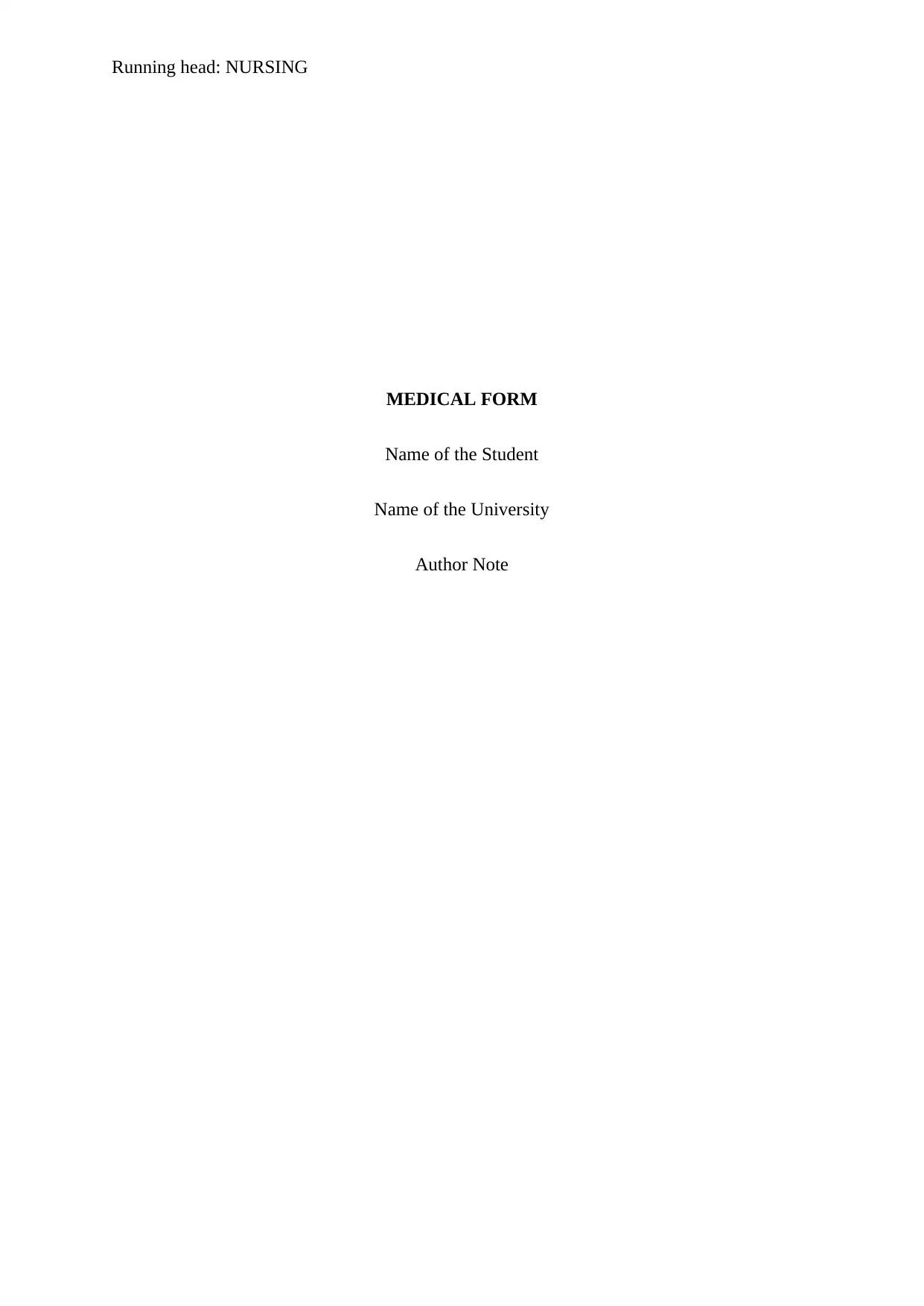
Running head: NURSING
MEDICAL FORM
Name of the Student
Name of the University
Author Note
MEDICAL FORM
Name of the Student
Name of the University
Author Note
Secure Best Marks with AI Grader
Need help grading? Try our AI Grader for instant feedback on your assignments.
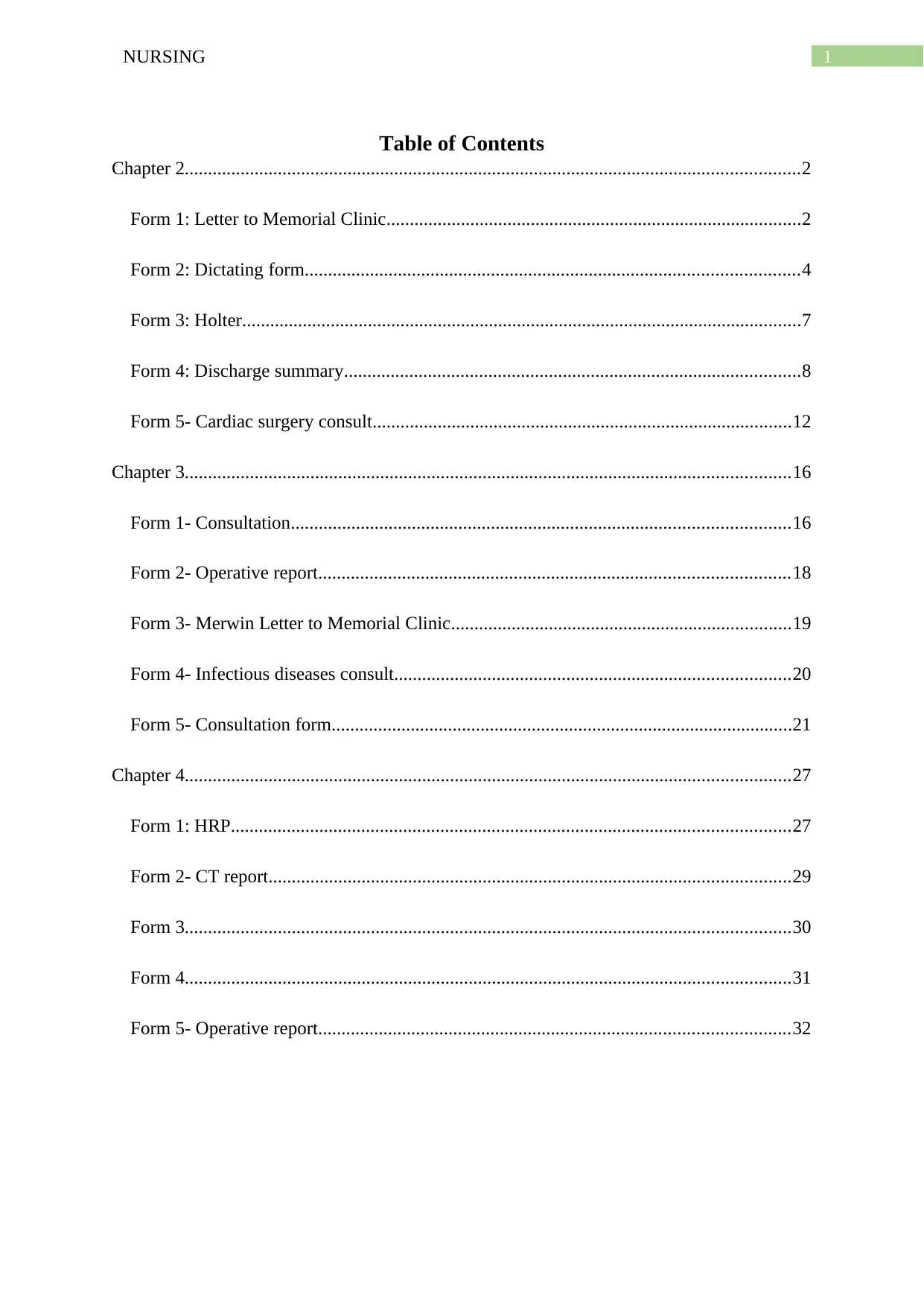
1NURSING
Table of Contents
Chapter 2....................................................................................................................................2
Form 1: Letter to Memorial Clinic.........................................................................................2
Form 2: Dictating form..........................................................................................................4
Form 3: Holter........................................................................................................................7
Form 4: Discharge summary..................................................................................................8
Form 5- Cardiac surgery consult..........................................................................................12
Chapter 3..................................................................................................................................16
Form 1- Consultation...........................................................................................................16
Form 2- Operative report.....................................................................................................18
Form 3- Merwin Letter to Memorial Clinic.........................................................................19
Form 4- Infectious diseases consult.....................................................................................20
Form 5- Consultation form...................................................................................................21
Chapter 4..................................................................................................................................27
Form 1: HRP........................................................................................................................27
Form 2- CT report................................................................................................................29
Form 3..................................................................................................................................30
Form 4..................................................................................................................................31
Form 5- Operative report.....................................................................................................32
Table of Contents
Chapter 2....................................................................................................................................2
Form 1: Letter to Memorial Clinic.........................................................................................2
Form 2: Dictating form..........................................................................................................4
Form 3: Holter........................................................................................................................7
Form 4: Discharge summary..................................................................................................8
Form 5- Cardiac surgery consult..........................................................................................12
Chapter 3..................................................................................................................................16
Form 1- Consultation...........................................................................................................16
Form 2- Operative report.....................................................................................................18
Form 3- Merwin Letter to Memorial Clinic.........................................................................19
Form 4- Infectious diseases consult.....................................................................................20
Form 5- Consultation form...................................................................................................21
Chapter 4..................................................................................................................................27
Form 1: HRP........................................................................................................................27
Form 2- CT report................................................................................................................29
Form 3..................................................................................................................................30
Form 4..................................................................................................................................31
Form 5- Operative report.....................................................................................................32
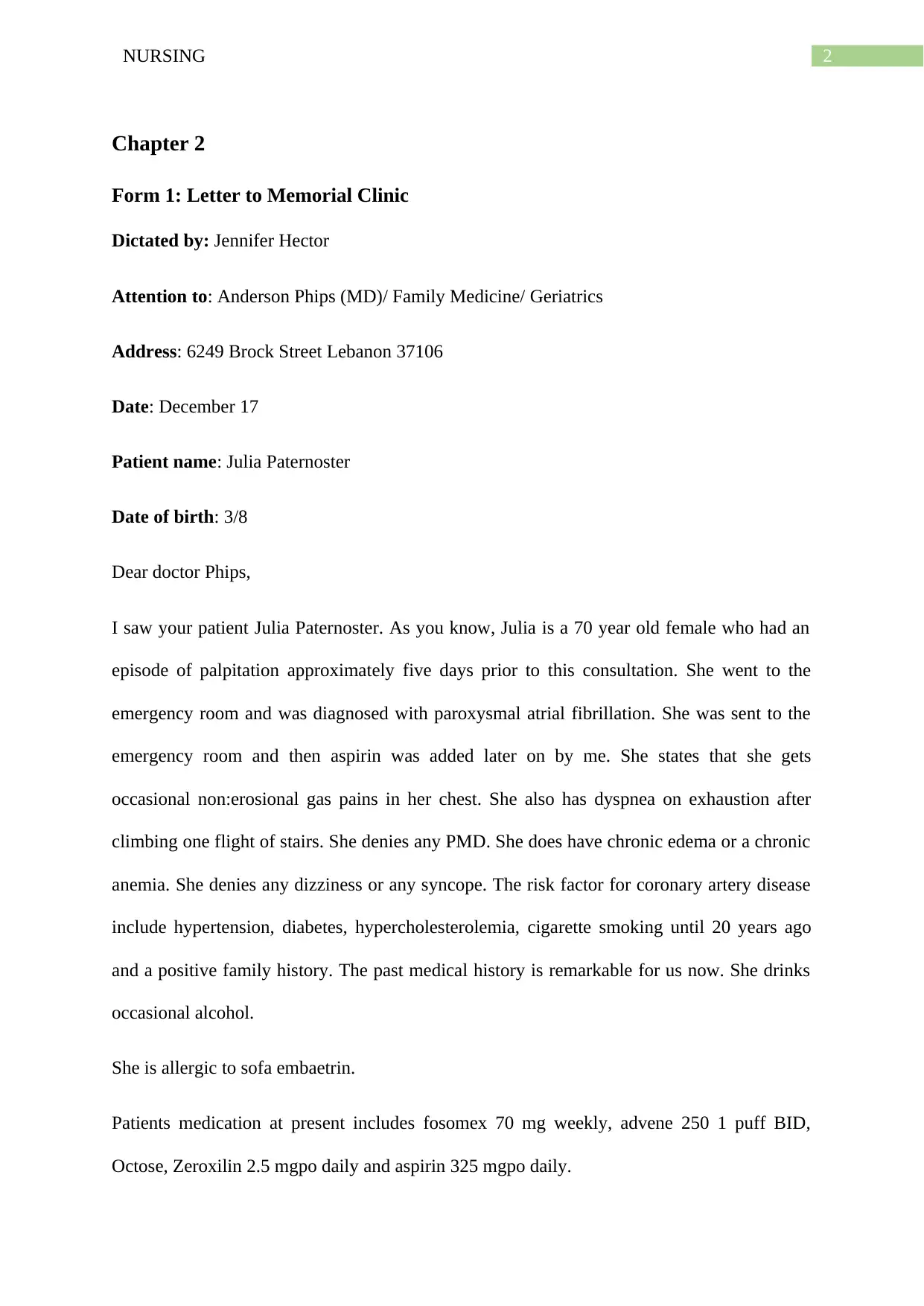
2NURSING
Chapter 2
Form 1: Letter to Memorial Clinic
Dictated by: Jennifer Hector
Attention to: Anderson Phips (MD)/ Family Medicine/ Geriatrics
Address: 6249 Brock Street Lebanon 37106
Date: December 17
Patient name: Julia Paternoster
Date of birth: 3/8
Dear doctor Phips,
I saw your patient Julia Paternoster. As you know, Julia is a 70 year old female who had an
episode of palpitation approximately five days prior to this consultation. She went to the
emergency room and was diagnosed with paroxysmal atrial fibrillation. She was sent to the
emergency room and then aspirin was added later on by me. She states that she gets
occasional non:erosional gas pains in her chest. She also has dyspnea on exhaustion after
climbing one flight of stairs. She denies any PMD. She does have chronic edema or a chronic
anemia. She denies any dizziness or any syncope. The risk factor for coronary artery disease
include hypertension, diabetes, hypercholesterolemia, cigarette smoking until 20 years ago
and a positive family history. The past medical history is remarkable for us now. She drinks
occasional alcohol.
She is allergic to sofa embaetrin.
Patients medication at present includes fosomex 70 mg weekly, advene 250 1 puff BID,
Octose, Zeroxilin 2.5 mgpo daily and aspirin 325 mgpo daily.
Chapter 2
Form 1: Letter to Memorial Clinic
Dictated by: Jennifer Hector
Attention to: Anderson Phips (MD)/ Family Medicine/ Geriatrics
Address: 6249 Brock Street Lebanon 37106
Date: December 17
Patient name: Julia Paternoster
Date of birth: 3/8
Dear doctor Phips,
I saw your patient Julia Paternoster. As you know, Julia is a 70 year old female who had an
episode of palpitation approximately five days prior to this consultation. She went to the
emergency room and was diagnosed with paroxysmal atrial fibrillation. She was sent to the
emergency room and then aspirin was added later on by me. She states that she gets
occasional non:erosional gas pains in her chest. She also has dyspnea on exhaustion after
climbing one flight of stairs. She denies any PMD. She does have chronic edema or a chronic
anemia. She denies any dizziness or any syncope. The risk factor for coronary artery disease
include hypertension, diabetes, hypercholesterolemia, cigarette smoking until 20 years ago
and a positive family history. The past medical history is remarkable for us now. She drinks
occasional alcohol.
She is allergic to sofa embaetrin.
Patients medication at present includes fosomex 70 mg weekly, advene 250 1 puff BID,
Octose, Zeroxilin 2.5 mgpo daily and aspirin 325 mgpo daily.
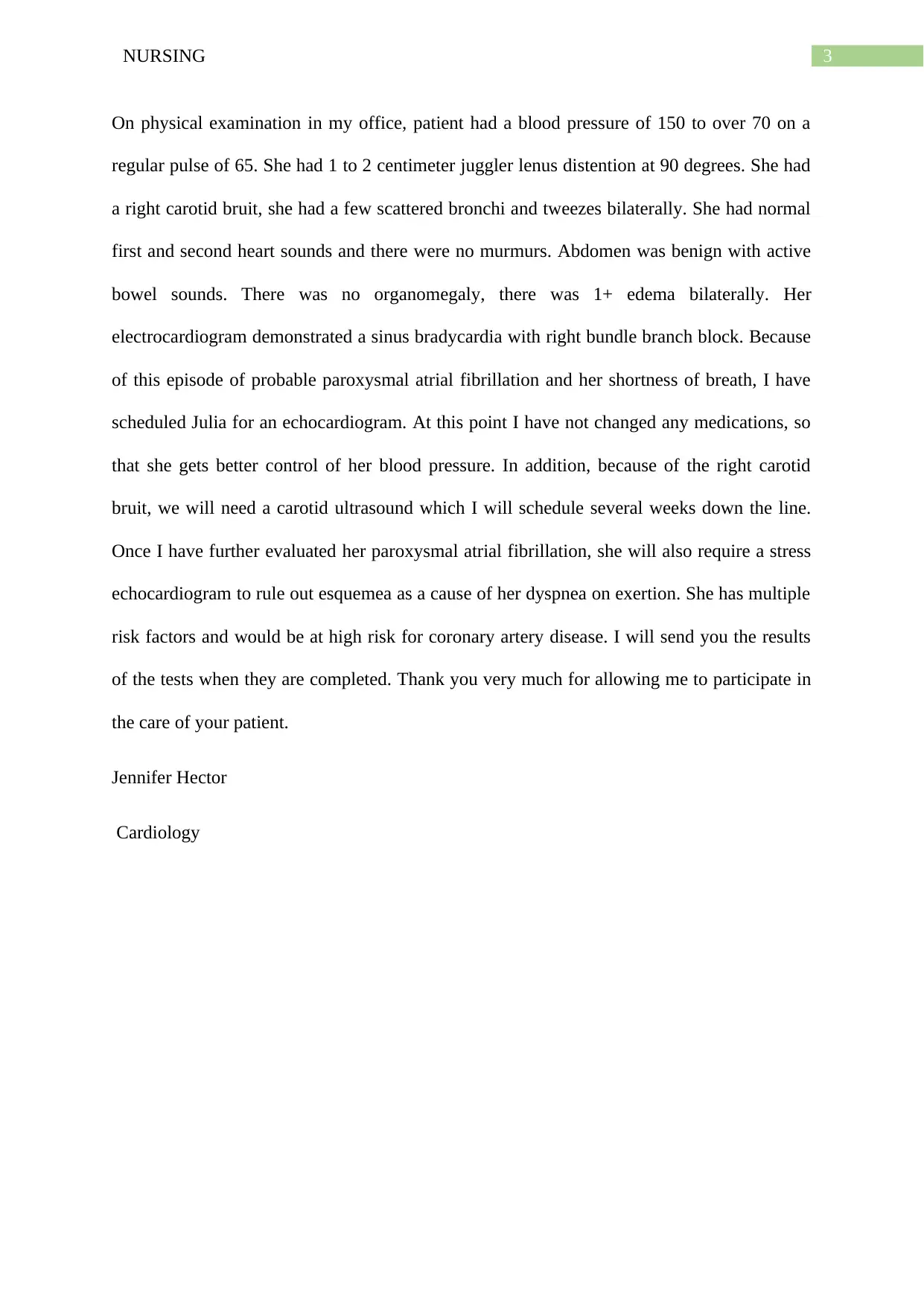
3NURSING
On physical examination in my office, patient had a blood pressure of 150 to over 70 on a
regular pulse of 65. She had 1 to 2 centimeter juggler lenus distention at 90 degrees. She had
a right carotid bruit, she had a few scattered bronchi and tweezes bilaterally. She had normal
first and second heart sounds and there were no murmurs. Abdomen was benign with active
bowel sounds. There was no organomegaly, there was 1+ edema bilaterally. Her
electrocardiogram demonstrated a sinus bradycardia with right bundle branch block. Because
of this episode of probable paroxysmal atrial fibrillation and her shortness of breath, I have
scheduled Julia for an echocardiogram. At this point I have not changed any medications, so
that she gets better control of her blood pressure. In addition, because of the right carotid
bruit, we will need a carotid ultrasound which I will schedule several weeks down the line.
Once I have further evaluated her paroxysmal atrial fibrillation, she will also require a stress
echocardiogram to rule out esquemea as a cause of her dyspnea on exertion. She has multiple
risk factors and would be at high risk for coronary artery disease. I will send you the results
of the tests when they are completed. Thank you very much for allowing me to participate in
the care of your patient.
Jennifer Hector
Cardiology
On physical examination in my office, patient had a blood pressure of 150 to over 70 on a
regular pulse of 65. She had 1 to 2 centimeter juggler lenus distention at 90 degrees. She had
a right carotid bruit, she had a few scattered bronchi and tweezes bilaterally. She had normal
first and second heart sounds and there were no murmurs. Abdomen was benign with active
bowel sounds. There was no organomegaly, there was 1+ edema bilaterally. Her
electrocardiogram demonstrated a sinus bradycardia with right bundle branch block. Because
of this episode of probable paroxysmal atrial fibrillation and her shortness of breath, I have
scheduled Julia for an echocardiogram. At this point I have not changed any medications, so
that she gets better control of her blood pressure. In addition, because of the right carotid
bruit, we will need a carotid ultrasound which I will schedule several weeks down the line.
Once I have further evaluated her paroxysmal atrial fibrillation, she will also require a stress
echocardiogram to rule out esquemea as a cause of her dyspnea on exertion. She has multiple
risk factors and would be at high risk for coronary artery disease. I will send you the results
of the tests when they are completed. Thank you very much for allowing me to participate in
the care of your patient.
Jennifer Hector
Cardiology
Secure Best Marks with AI Grader
Need help grading? Try our AI Grader for instant feedback on your assignments.
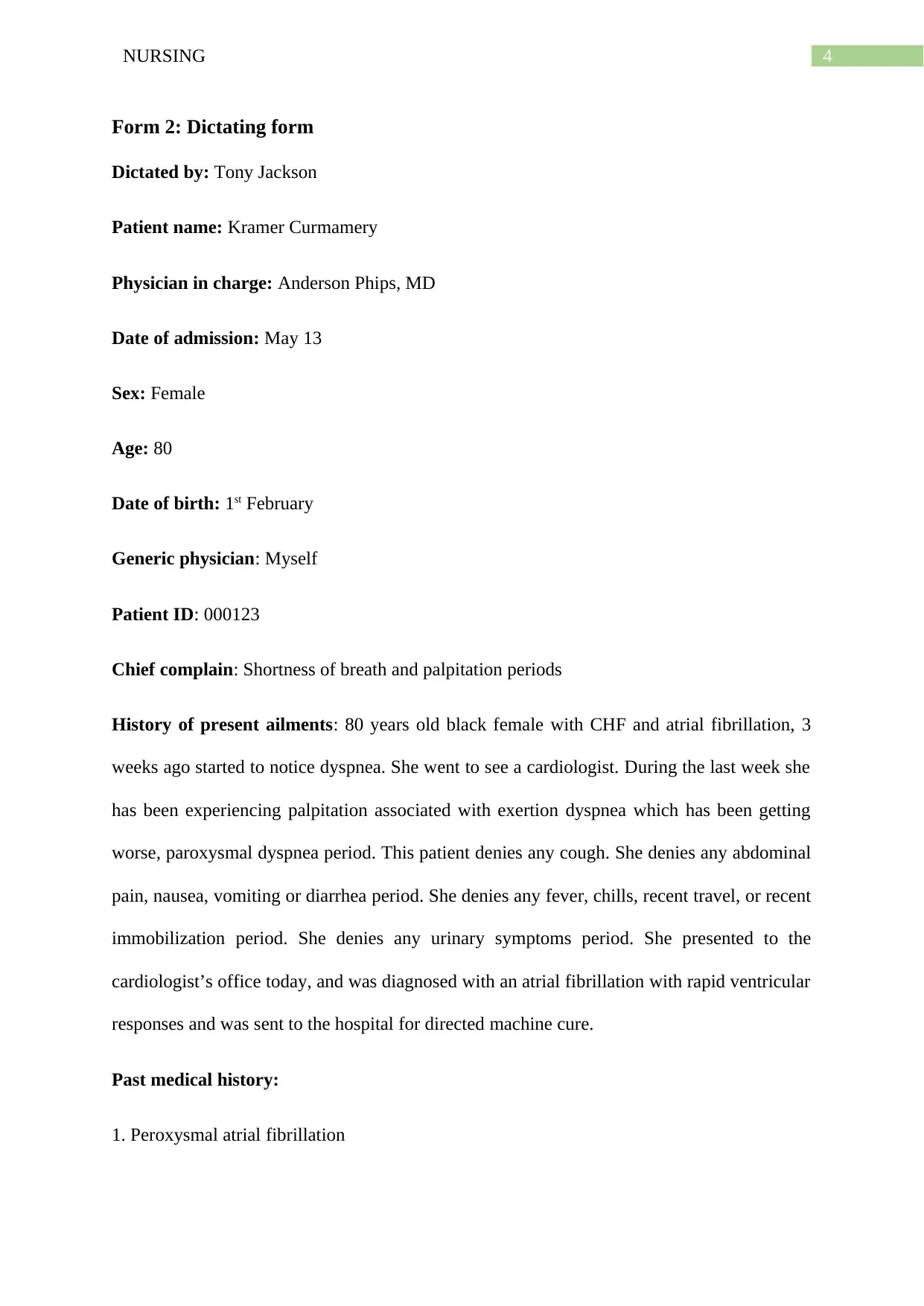
4NURSING
Form 2: Dictating form
Dictated by: Tony Jackson
Patient name: Kramer Curmamery
Physician in charge: Anderson Phips, MD
Date of admission: May 13
Sex: Female
Age: 80
Date of birth: 1st February
Generic physician: Myself
Patient ID: 000123
Chief complain: Shortness of breath and palpitation periods
History of present ailments: 80 years old black female with CHF and atrial fibrillation, 3
weeks ago started to notice dyspnea. She went to see a cardiologist. During the last week she
has been experiencing palpitation associated with exertion dyspnea which has been getting
worse, paroxysmal dyspnea period. This patient denies any cough. She denies any abdominal
pain, nausea, vomiting or diarrhea period. She denies any fever, chills, recent travel, or recent
immobilization period. She denies any urinary symptoms period. She presented to the
cardiologist’s office today, and was diagnosed with an atrial fibrillation with rapid ventricular
responses and was sent to the hospital for directed machine cure.
Past medical history:
1. Peroxysmal atrial fibrillation
Form 2: Dictating form
Dictated by: Tony Jackson
Patient name: Kramer Curmamery
Physician in charge: Anderson Phips, MD
Date of admission: May 13
Sex: Female
Age: 80
Date of birth: 1st February
Generic physician: Myself
Patient ID: 000123
Chief complain: Shortness of breath and palpitation periods
History of present ailments: 80 years old black female with CHF and atrial fibrillation, 3
weeks ago started to notice dyspnea. She went to see a cardiologist. During the last week she
has been experiencing palpitation associated with exertion dyspnea which has been getting
worse, paroxysmal dyspnea period. This patient denies any cough. She denies any abdominal
pain, nausea, vomiting or diarrhea period. She denies any fever, chills, recent travel, or recent
immobilization period. She denies any urinary symptoms period. She presented to the
cardiologist’s office today, and was diagnosed with an atrial fibrillation with rapid ventricular
responses and was sent to the hospital for directed machine cure.
Past medical history:
1. Peroxysmal atrial fibrillation
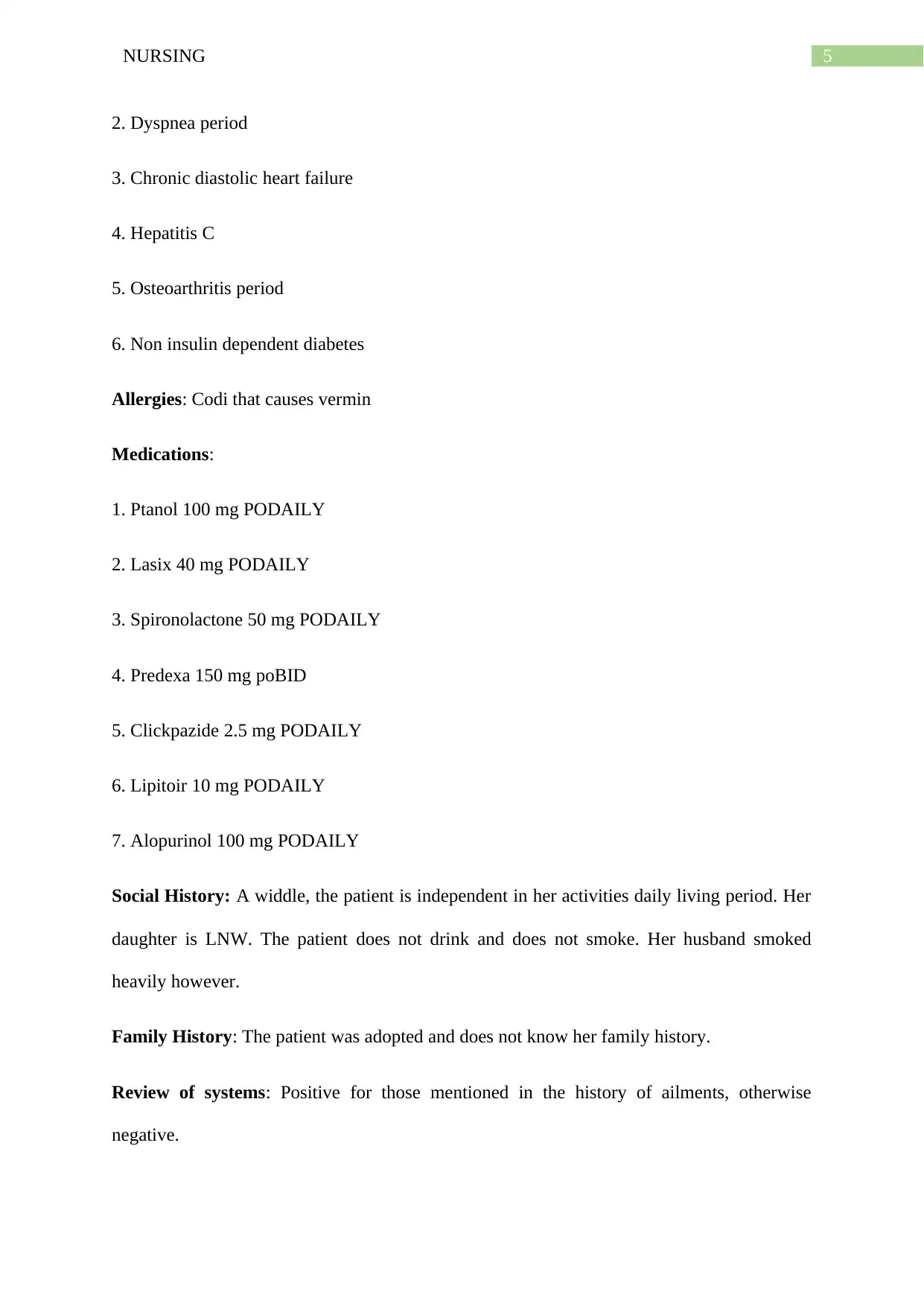
5NURSING
2. Dyspnea period
3. Chronic diastolic heart failure
4. Hepatitis C
5. Osteoarthritis period
6. Non insulin dependent diabetes
Allergies: Codi that causes vermin
Medications:
1. Ptanol 100 mg PODAILY
2. Lasix 40 mg PODAILY
3. Spironolactone 50 mg PODAILY
4. Predexa 150 mg poBID
5. Clickpazide 2.5 mg PODAILY
6. Lipitoir 10 mg PODAILY
7. Alopurinol 100 mg PODAILY
Social History: A widdle, the patient is independent in her activities daily living period. Her
daughter is LNW. The patient does not drink and does not smoke. Her husband smoked
heavily however.
Family History: The patient was adopted and does not know her family history.
Review of systems: Positive for those mentioned in the history of ailments, otherwise
negative.
2. Dyspnea period
3. Chronic diastolic heart failure
4. Hepatitis C
5. Osteoarthritis period
6. Non insulin dependent diabetes
Allergies: Codi that causes vermin
Medications:
1. Ptanol 100 mg PODAILY
2. Lasix 40 mg PODAILY
3. Spironolactone 50 mg PODAILY
4. Predexa 150 mg poBID
5. Clickpazide 2.5 mg PODAILY
6. Lipitoir 10 mg PODAILY
7. Alopurinol 100 mg PODAILY
Social History: A widdle, the patient is independent in her activities daily living period. Her
daughter is LNW. The patient does not drink and does not smoke. Her husband smoked
heavily however.
Family History: The patient was adopted and does not know her family history.
Review of systems: Positive for those mentioned in the history of ailments, otherwise
negative.
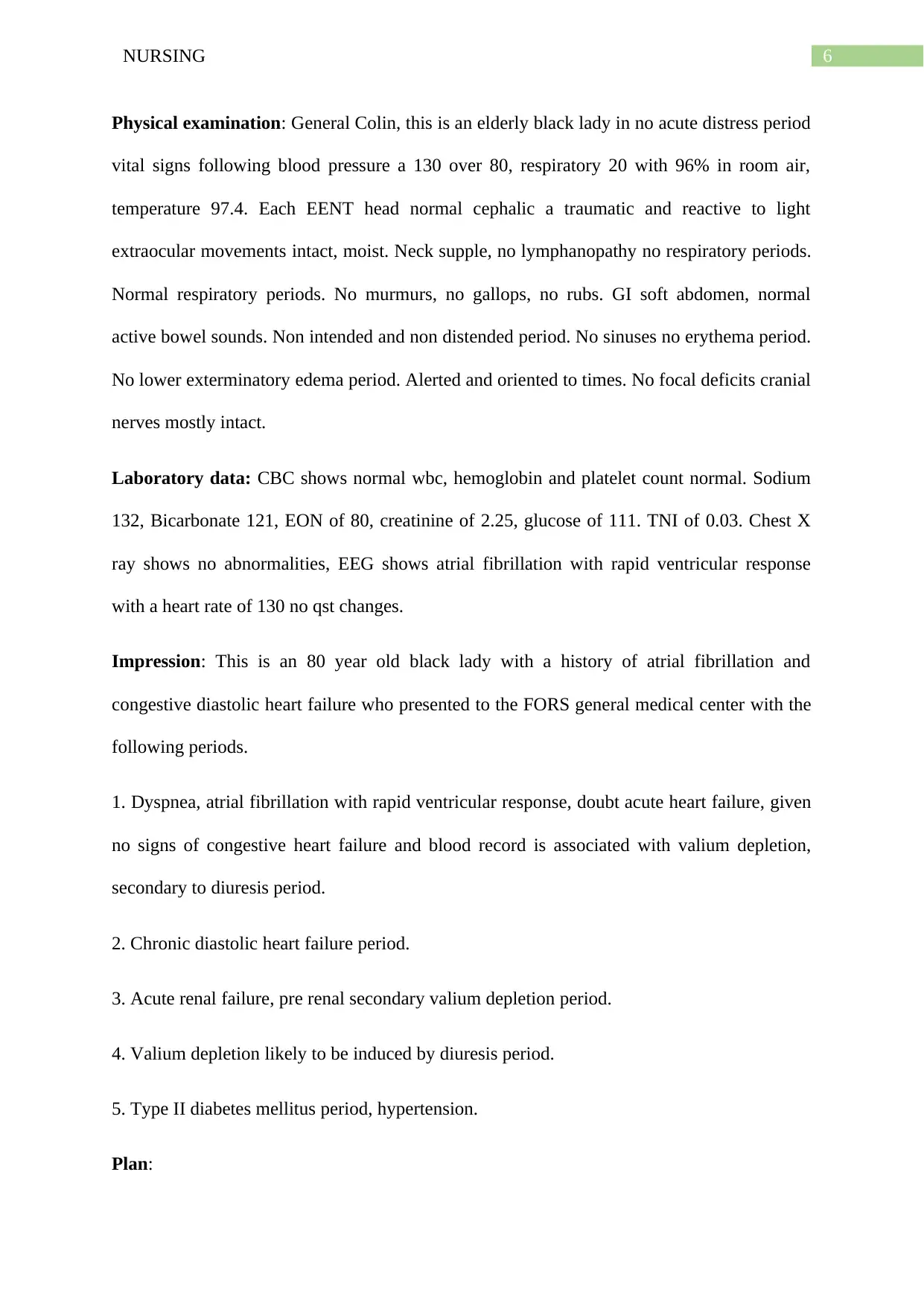
6NURSING
Physical examination: General Colin, this is an elderly black lady in no acute distress period
vital signs following blood pressure a 130 over 80, respiratory 20 with 96% in room air,
temperature 97.4. Each EENT head normal cephalic a traumatic and reactive to light
extraocular movements intact, moist. Neck supple, no lymphanopathy no respiratory periods.
Normal respiratory periods. No murmurs, no gallops, no rubs. GI soft abdomen, normal
active bowel sounds. Non intended and non distended period. No sinuses no erythema period.
No lower exterminatory edema period. Alerted and oriented to times. No focal deficits cranial
nerves mostly intact.
Laboratory data: CBC shows normal wbc, hemoglobin and platelet count normal. Sodium
132, Bicarbonate 121, EON of 80, creatinine of 2.25, glucose of 111. TNI of 0.03. Chest X
ray shows no abnormalities, EEG shows atrial fibrillation with rapid ventricular response
with a heart rate of 130 no qst changes.
Impression: This is an 80 year old black lady with a history of atrial fibrillation and
congestive diastolic heart failure who presented to the FORS general medical center with the
following periods.
1. Dyspnea, atrial fibrillation with rapid ventricular response, doubt acute heart failure, given
no signs of congestive heart failure and blood record is associated with valium depletion,
secondary to diuresis period.
2. Chronic diastolic heart failure period.
3. Acute renal failure, pre renal secondary valium depletion period.
4. Valium depletion likely to be induced by diuresis period.
5. Type II diabetes mellitus period, hypertension.
Plan:
Physical examination: General Colin, this is an elderly black lady in no acute distress period
vital signs following blood pressure a 130 over 80, respiratory 20 with 96% in room air,
temperature 97.4. Each EENT head normal cephalic a traumatic and reactive to light
extraocular movements intact, moist. Neck supple, no lymphanopathy no respiratory periods.
Normal respiratory periods. No murmurs, no gallops, no rubs. GI soft abdomen, normal
active bowel sounds. Non intended and non distended period. No sinuses no erythema period.
No lower exterminatory edema period. Alerted and oriented to times. No focal deficits cranial
nerves mostly intact.
Laboratory data: CBC shows normal wbc, hemoglobin and platelet count normal. Sodium
132, Bicarbonate 121, EON of 80, creatinine of 2.25, glucose of 111. TNI of 0.03. Chest X
ray shows no abnormalities, EEG shows atrial fibrillation with rapid ventricular response
with a heart rate of 130 no qst changes.
Impression: This is an 80 year old black lady with a history of atrial fibrillation and
congestive diastolic heart failure who presented to the FORS general medical center with the
following periods.
1. Dyspnea, atrial fibrillation with rapid ventricular response, doubt acute heart failure, given
no signs of congestive heart failure and blood record is associated with valium depletion,
secondary to diuresis period.
2. Chronic diastolic heart failure period.
3. Acute renal failure, pre renal secondary valium depletion period.
4. Valium depletion likely to be induced by diuresis period.
5. Type II diabetes mellitus period, hypertension.
Plan:
Paraphrase This Document
Need a fresh take? Get an instant paraphrase of this document with our AI Paraphraser
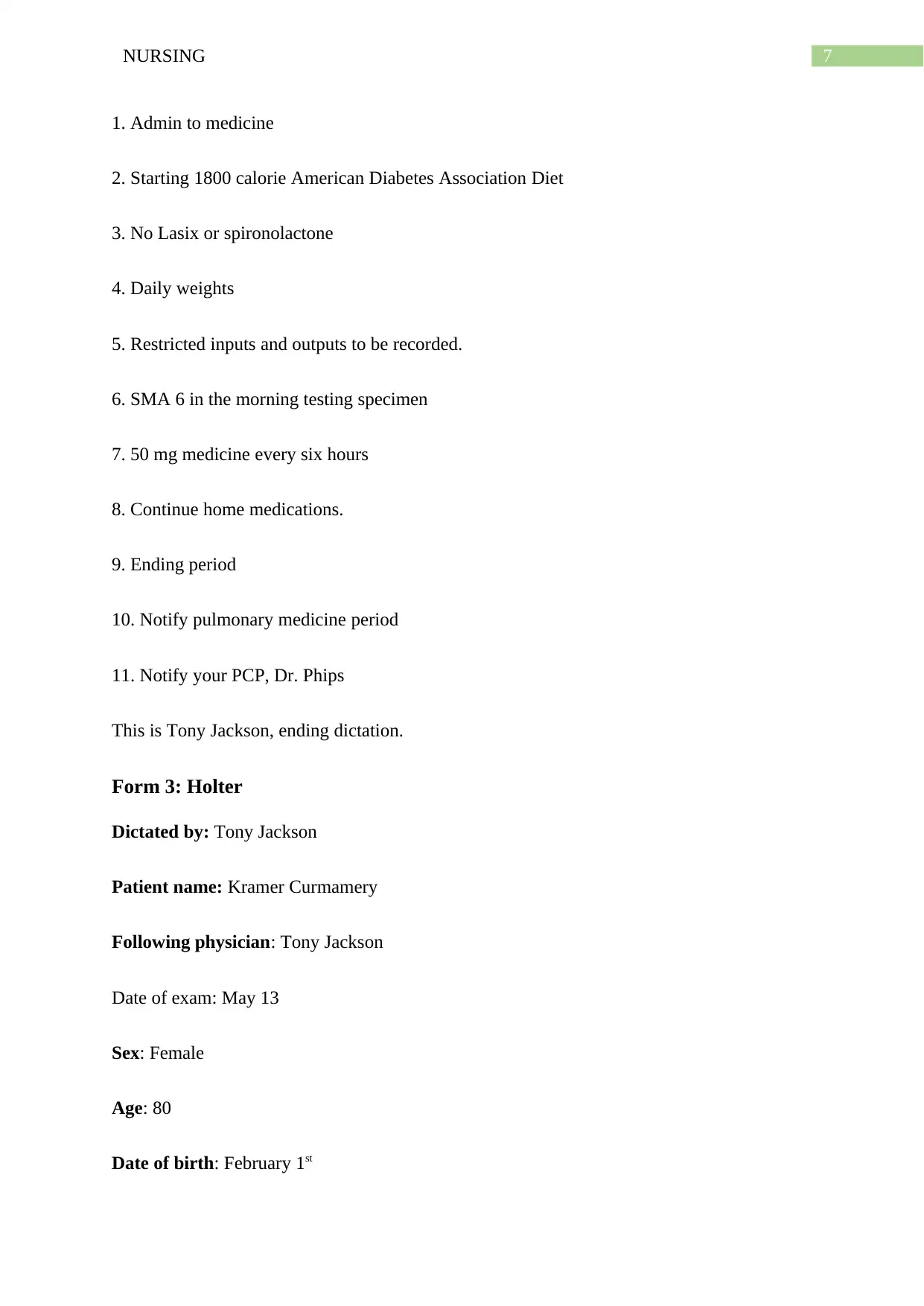
7NURSING
1. Admin to medicine
2. Starting 1800 calorie American Diabetes Association Diet
3. No Lasix or spironolactone
4. Daily weights
5. Restricted inputs and outputs to be recorded.
6. SMA 6 in the morning testing specimen
7. 50 mg medicine every six hours
8. Continue home medications.
9. Ending period
10. Notify pulmonary medicine period
11. Notify your PCP, Dr. Phips
This is Tony Jackson, ending dictation.
Form 3: Holter
Dictated by: Tony Jackson
Patient name: Kramer Curmamery
Following physician: Tony Jackson
Date of exam: May 13
Sex: Female
Age: 80
Date of birth: February 1st
1. Admin to medicine
2. Starting 1800 calorie American Diabetes Association Diet
3. No Lasix or spironolactone
4. Daily weights
5. Restricted inputs and outputs to be recorded.
6. SMA 6 in the morning testing specimen
7. 50 mg medicine every six hours
8. Continue home medications.
9. Ending period
10. Notify pulmonary medicine period
11. Notify your PCP, Dr. Phips
This is Tony Jackson, ending dictation.
Form 3: Holter
Dictated by: Tony Jackson
Patient name: Kramer Curmamery
Following physician: Tony Jackson
Date of exam: May 13
Sex: Female
Age: 80
Date of birth: February 1st
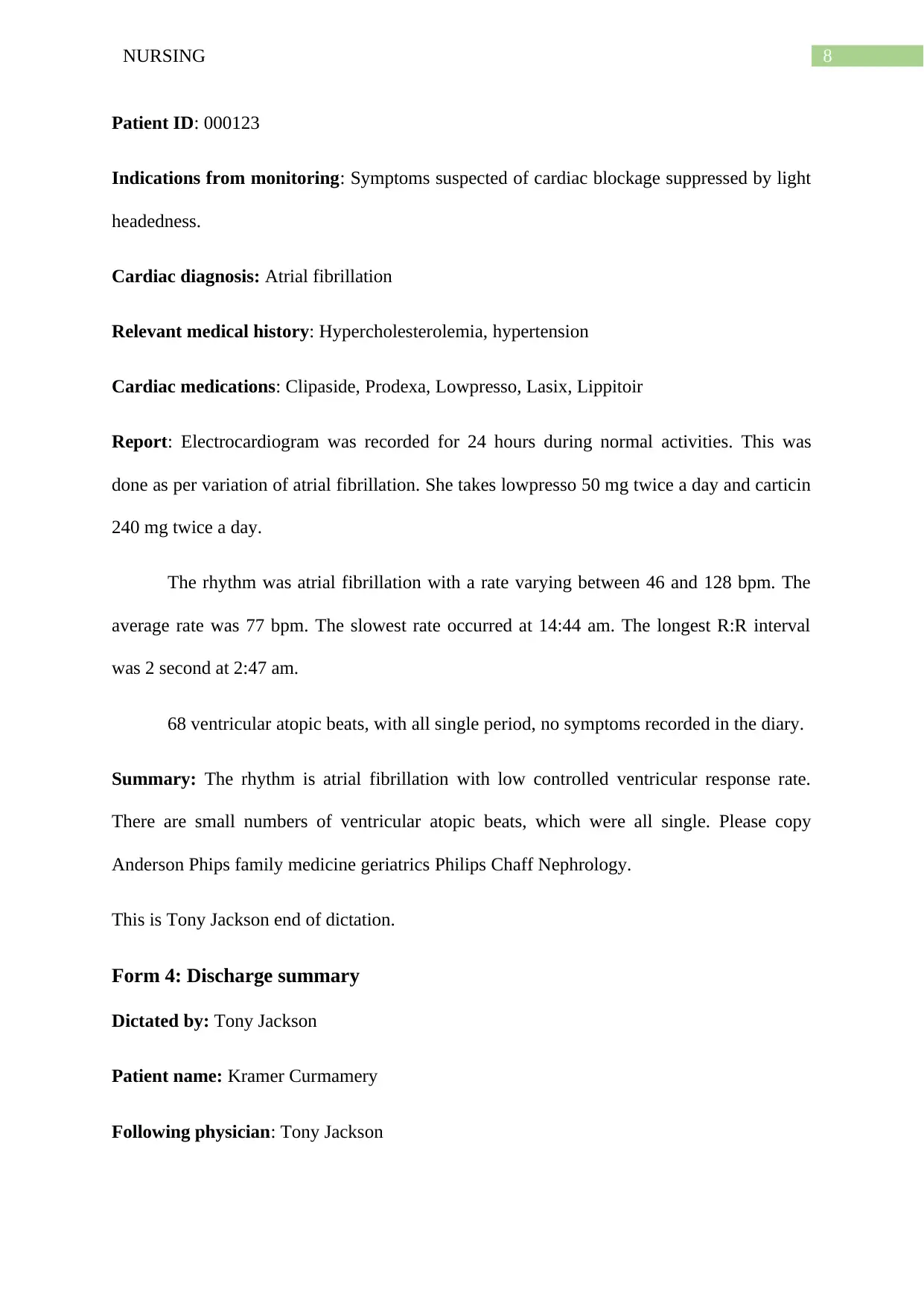
8NURSING
Patient ID: 000123
Indications from monitoring: Symptoms suspected of cardiac blockage suppressed by light
headedness.
Cardiac diagnosis: Atrial fibrillation
Relevant medical history: Hypercholesterolemia, hypertension
Cardiac medications: Clipaside, Prodexa, Lowpresso, Lasix, Lippitoir
Report: Electrocardiogram was recorded for 24 hours during normal activities. This was
done as per variation of atrial fibrillation. She takes lowpresso 50 mg twice a day and carticin
240 mg twice a day.
The rhythm was atrial fibrillation with a rate varying between 46 and 128 bpm. The
average rate was 77 bpm. The slowest rate occurred at 14:44 am. The longest R:R interval
was 2 second at 2:47 am.
68 ventricular atopic beats, with all single period, no symptoms recorded in the diary.
Summary: The rhythm is atrial fibrillation with low controlled ventricular response rate.
There are small numbers of ventricular atopic beats, which were all single. Please copy
Anderson Phips family medicine geriatrics Philips Chaff Nephrology.
This is Tony Jackson end of dictation.
Form 4: Discharge summary
Dictated by: Tony Jackson
Patient name: Kramer Curmamery
Following physician: Tony Jackson
Patient ID: 000123
Indications from monitoring: Symptoms suspected of cardiac blockage suppressed by light
headedness.
Cardiac diagnosis: Atrial fibrillation
Relevant medical history: Hypercholesterolemia, hypertension
Cardiac medications: Clipaside, Prodexa, Lowpresso, Lasix, Lippitoir
Report: Electrocardiogram was recorded for 24 hours during normal activities. This was
done as per variation of atrial fibrillation. She takes lowpresso 50 mg twice a day and carticin
240 mg twice a day.
The rhythm was atrial fibrillation with a rate varying between 46 and 128 bpm. The
average rate was 77 bpm. The slowest rate occurred at 14:44 am. The longest R:R interval
was 2 second at 2:47 am.
68 ventricular atopic beats, with all single period, no symptoms recorded in the diary.
Summary: The rhythm is atrial fibrillation with low controlled ventricular response rate.
There are small numbers of ventricular atopic beats, which were all single. Please copy
Anderson Phips family medicine geriatrics Philips Chaff Nephrology.
This is Tony Jackson end of dictation.
Form 4: Discharge summary
Dictated by: Tony Jackson
Patient name: Kramer Curmamery
Following physician: Tony Jackson
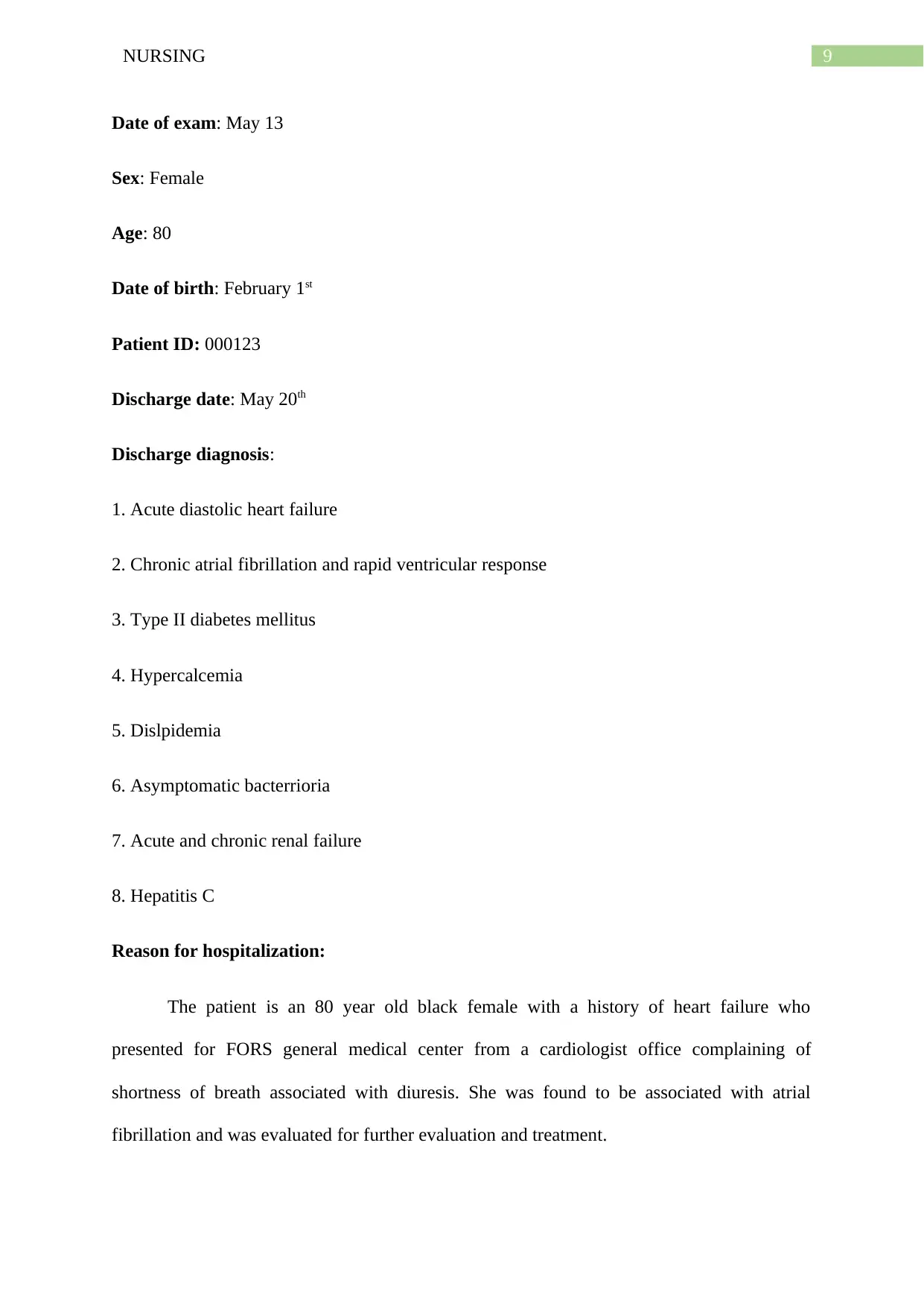
9NURSING
Date of exam: May 13
Sex: Female
Age: 80
Date of birth: February 1st
Patient ID: 000123
Discharge date: May 20th
Discharge diagnosis:
1. Acute diastolic heart failure
2. Chronic atrial fibrillation and rapid ventricular response
3. Type II diabetes mellitus
4. Hypercalcemia
5. Dislpidemia
6. Asymptomatic bacterrioria
7. Acute and chronic renal failure
8. Hepatitis C
Reason for hospitalization:
The patient is an 80 year old black female with a history of heart failure who
presented for FORS general medical center from a cardiologist office complaining of
shortness of breath associated with diuresis. She was found to be associated with atrial
fibrillation and was evaluated for further evaluation and treatment.
Date of exam: May 13
Sex: Female
Age: 80
Date of birth: February 1st
Patient ID: 000123
Discharge date: May 20th
Discharge diagnosis:
1. Acute diastolic heart failure
2. Chronic atrial fibrillation and rapid ventricular response
3. Type II diabetes mellitus
4. Hypercalcemia
5. Dislpidemia
6. Asymptomatic bacterrioria
7. Acute and chronic renal failure
8. Hepatitis C
Reason for hospitalization:
The patient is an 80 year old black female with a history of heart failure who
presented for FORS general medical center from a cardiologist office complaining of
shortness of breath associated with diuresis. She was found to be associated with atrial
fibrillation and was evaluated for further evaluation and treatment.
Secure Best Marks with AI Grader
Need help grading? Try our AI Grader for instant feedback on your assignments.
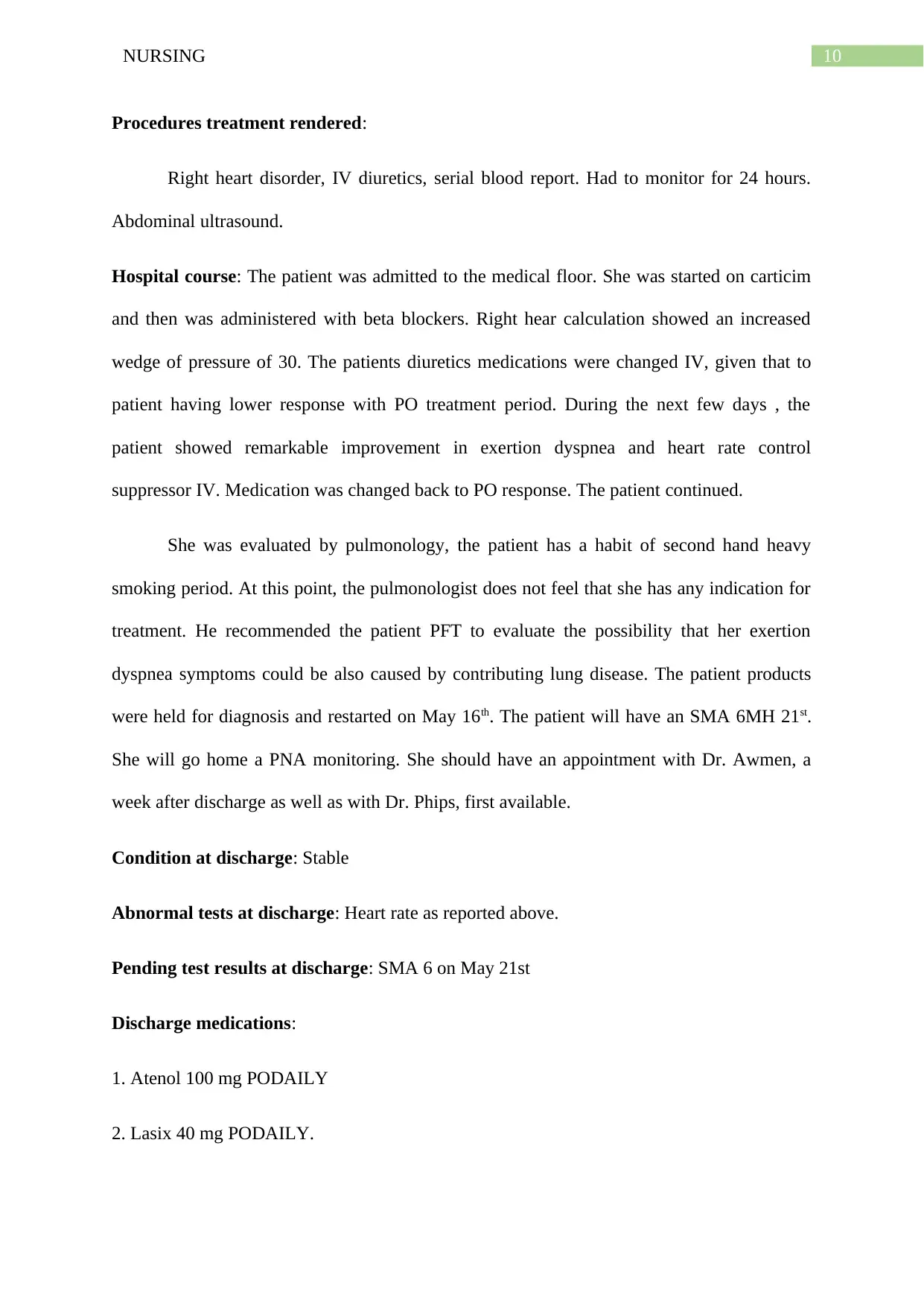
10NURSING
Procedures treatment rendered:
Right heart disorder, IV diuretics, serial blood report. Had to monitor for 24 hours.
Abdominal ultrasound.
Hospital course: The patient was admitted to the medical floor. She was started on carticim
and then was administered with beta blockers. Right hear calculation showed an increased
wedge of pressure of 30. The patients diuretics medications were changed IV, given that to
patient having lower response with PO treatment period. During the next few days , the
patient showed remarkable improvement in exertion dyspnea and heart rate control
suppressor IV. Medication was changed back to PO response. The patient continued.
She was evaluated by pulmonology, the patient has a habit of second hand heavy
smoking period. At this point, the pulmonologist does not feel that she has any indication for
treatment. He recommended the patient PFT to evaluate the possibility that her exertion
dyspnea symptoms could be also caused by contributing lung disease. The patient products
were held for diagnosis and restarted on May 16th. The patient will have an SMA 6MH 21st.
She will go home a PNA monitoring. She should have an appointment with Dr. Awmen, a
week after discharge as well as with Dr. Phips, first available.
Condition at discharge: Stable
Abnormal tests at discharge: Heart rate as reported above.
Pending test results at discharge: SMA 6 on May 21st
Discharge medications:
1. Atenol 100 mg PODAILY
2. Lasix 40 mg PODAILY.
Procedures treatment rendered:
Right heart disorder, IV diuretics, serial blood report. Had to monitor for 24 hours.
Abdominal ultrasound.
Hospital course: The patient was admitted to the medical floor. She was started on carticim
and then was administered with beta blockers. Right hear calculation showed an increased
wedge of pressure of 30. The patients diuretics medications were changed IV, given that to
patient having lower response with PO treatment period. During the next few days , the
patient showed remarkable improvement in exertion dyspnea and heart rate control
suppressor IV. Medication was changed back to PO response. The patient continued.
She was evaluated by pulmonology, the patient has a habit of second hand heavy
smoking period. At this point, the pulmonologist does not feel that she has any indication for
treatment. He recommended the patient PFT to evaluate the possibility that her exertion
dyspnea symptoms could be also caused by contributing lung disease. The patient products
were held for diagnosis and restarted on May 16th. The patient will have an SMA 6MH 21st.
She will go home a PNA monitoring. She should have an appointment with Dr. Awmen, a
week after discharge as well as with Dr. Phips, first available.
Condition at discharge: Stable
Abnormal tests at discharge: Heart rate as reported above.
Pending test results at discharge: SMA 6 on May 21st
Discharge medications:
1. Atenol 100 mg PODAILY
2. Lasix 40 mg PODAILY.
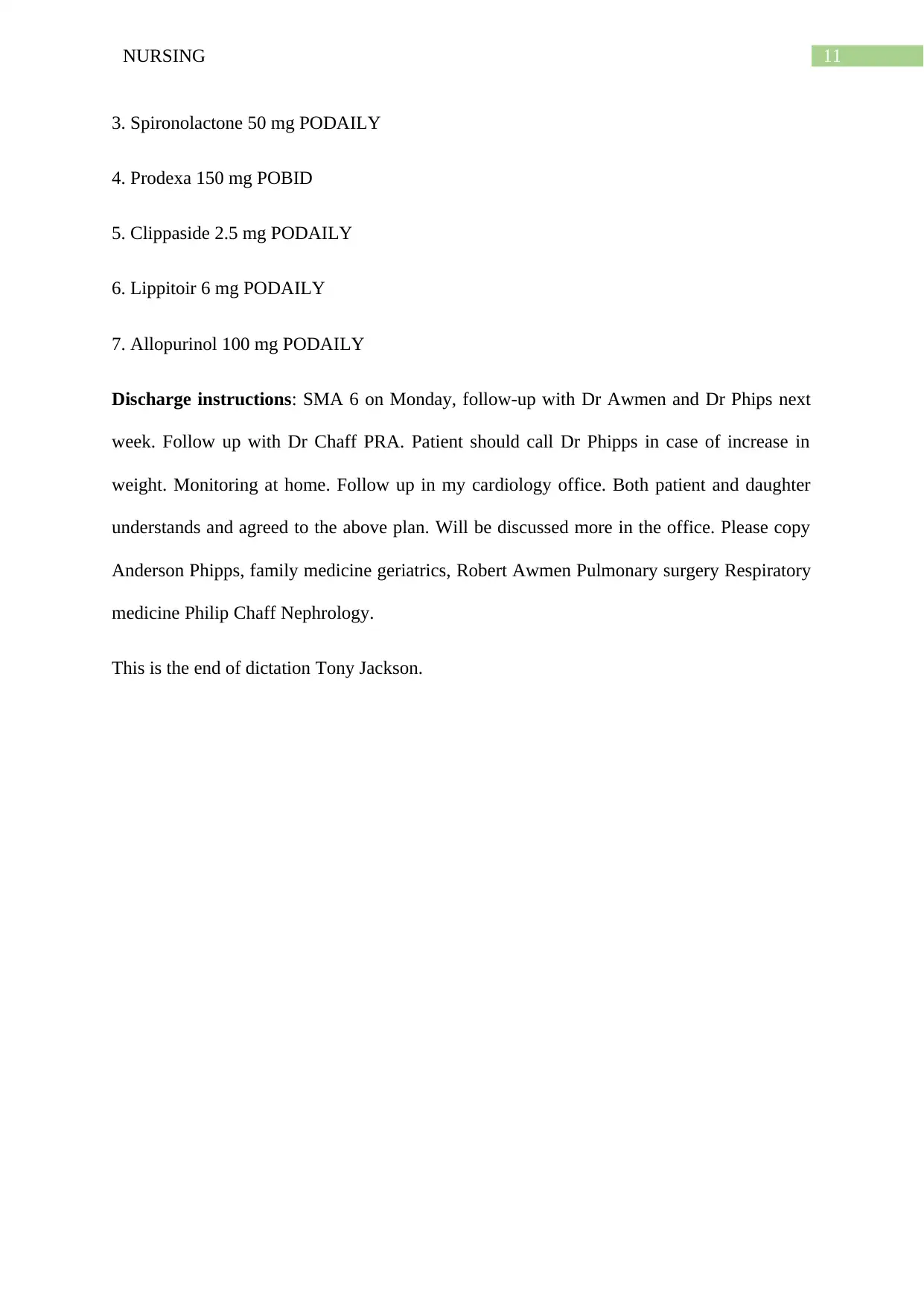
11NURSING
3. Spironolactone 50 mg PODAILY
4. Prodexa 150 mg POBID
5. Clippaside 2.5 mg PODAILY
6. Lippitoir 6 mg PODAILY
7. Allopurinol 100 mg PODAILY
Discharge instructions: SMA 6 on Monday, follow-up with Dr Awmen and Dr Phips next
week. Follow up with Dr Chaff PRA. Patient should call Dr Phipps in case of increase in
weight. Monitoring at home. Follow up in my cardiology office. Both patient and daughter
understands and agreed to the above plan. Will be discussed more in the office. Please copy
Anderson Phipps, family medicine geriatrics, Robert Awmen Pulmonary surgery Respiratory
medicine Philip Chaff Nephrology.
This is the end of dictation Tony Jackson.
3. Spironolactone 50 mg PODAILY
4. Prodexa 150 mg POBID
5. Clippaside 2.5 mg PODAILY
6. Lippitoir 6 mg PODAILY
7. Allopurinol 100 mg PODAILY
Discharge instructions: SMA 6 on Monday, follow-up with Dr Awmen and Dr Phips next
week. Follow up with Dr Chaff PRA. Patient should call Dr Phipps in case of increase in
weight. Monitoring at home. Follow up in my cardiology office. Both patient and daughter
understands and agreed to the above plan. Will be discussed more in the office. Please copy
Anderson Phipps, family medicine geriatrics, Robert Awmen Pulmonary surgery Respiratory
medicine Philip Chaff Nephrology.
This is the end of dictation Tony Jackson.
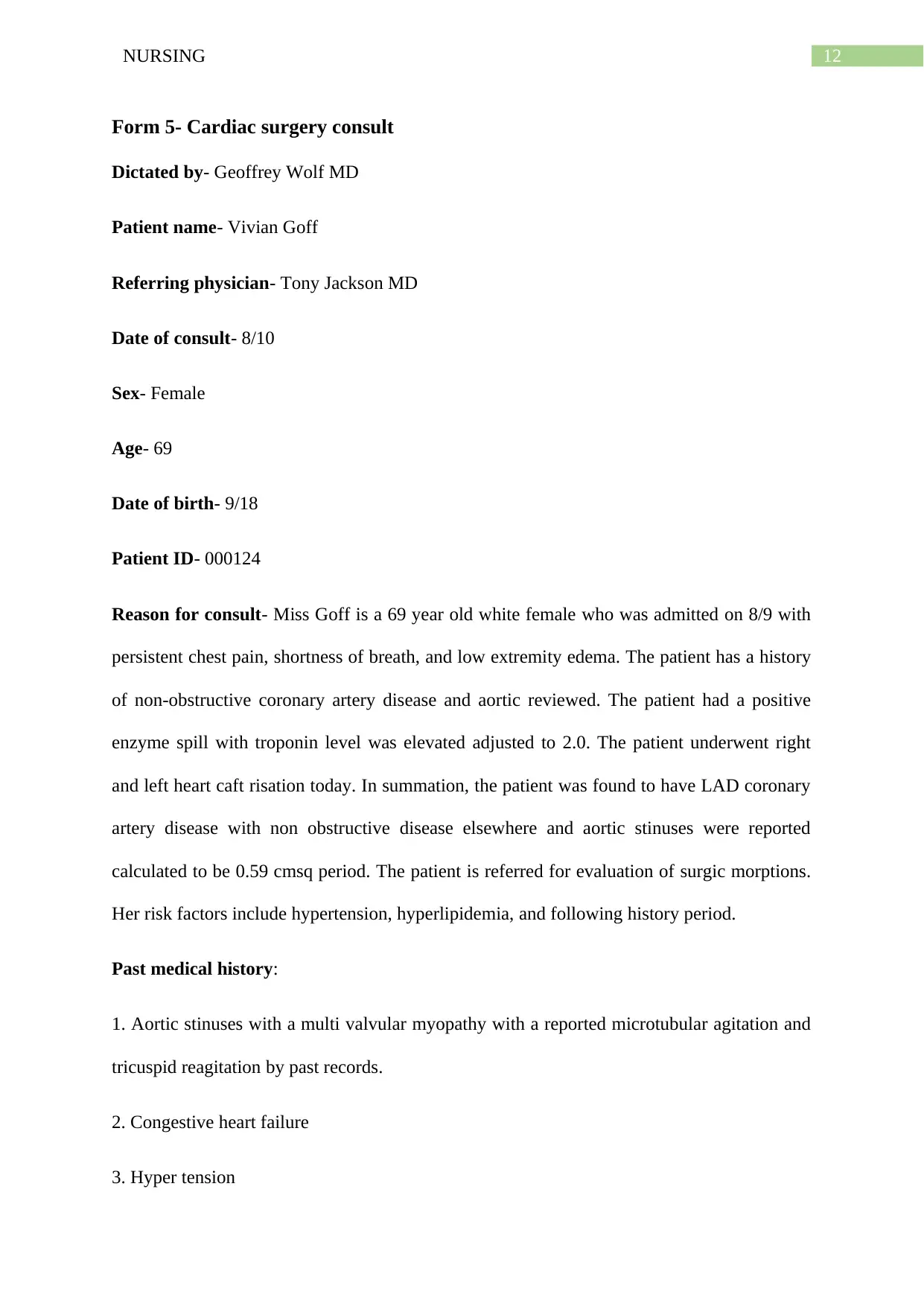
12NURSING
Form 5- Cardiac surgery consult
Dictated by- Geoffrey Wolf MD
Patient name- Vivian Goff
Referring physician- Tony Jackson MD
Date of consult- 8/10
Sex- Female
Age- 69
Date of birth- 9/18
Patient ID- 000124
Reason for consult- Miss Goff is a 69 year old white female who was admitted on 8/9 with
persistent chest pain, shortness of breath, and low extremity edema. The patient has a history
of non-obstructive coronary artery disease and aortic reviewed. The patient had a positive
enzyme spill with troponin level was elevated adjusted to 2.0. The patient underwent right
and left heart caft risation today. In summation, the patient was found to have LAD coronary
artery disease with non obstructive disease elsewhere and aortic stinuses were reported
calculated to be 0.59 cmsq period. The patient is referred for evaluation of surgic morptions.
Her risk factors include hypertension, hyperlipidemia, and following history period.
Past medical history:
1. Aortic stinuses with a multi valvular myopathy with a reported microtubular agitation and
tricuspid reagitation by past records.
2. Congestive heart failure
3. Hyper tension
Form 5- Cardiac surgery consult
Dictated by- Geoffrey Wolf MD
Patient name- Vivian Goff
Referring physician- Tony Jackson MD
Date of consult- 8/10
Sex- Female
Age- 69
Date of birth- 9/18
Patient ID- 000124
Reason for consult- Miss Goff is a 69 year old white female who was admitted on 8/9 with
persistent chest pain, shortness of breath, and low extremity edema. The patient has a history
of non-obstructive coronary artery disease and aortic reviewed. The patient had a positive
enzyme spill with troponin level was elevated adjusted to 2.0. The patient underwent right
and left heart caft risation today. In summation, the patient was found to have LAD coronary
artery disease with non obstructive disease elsewhere and aortic stinuses were reported
calculated to be 0.59 cmsq period. The patient is referred for evaluation of surgic morptions.
Her risk factors include hypertension, hyperlipidemia, and following history period.
Past medical history:
1. Aortic stinuses with a multi valvular myopathy with a reported microtubular agitation and
tricuspid reagitation by past records.
2. Congestive heart failure
3. Hyper tension
Paraphrase This Document
Need a fresh take? Get an instant paraphrase of this document with our AI Paraphraser
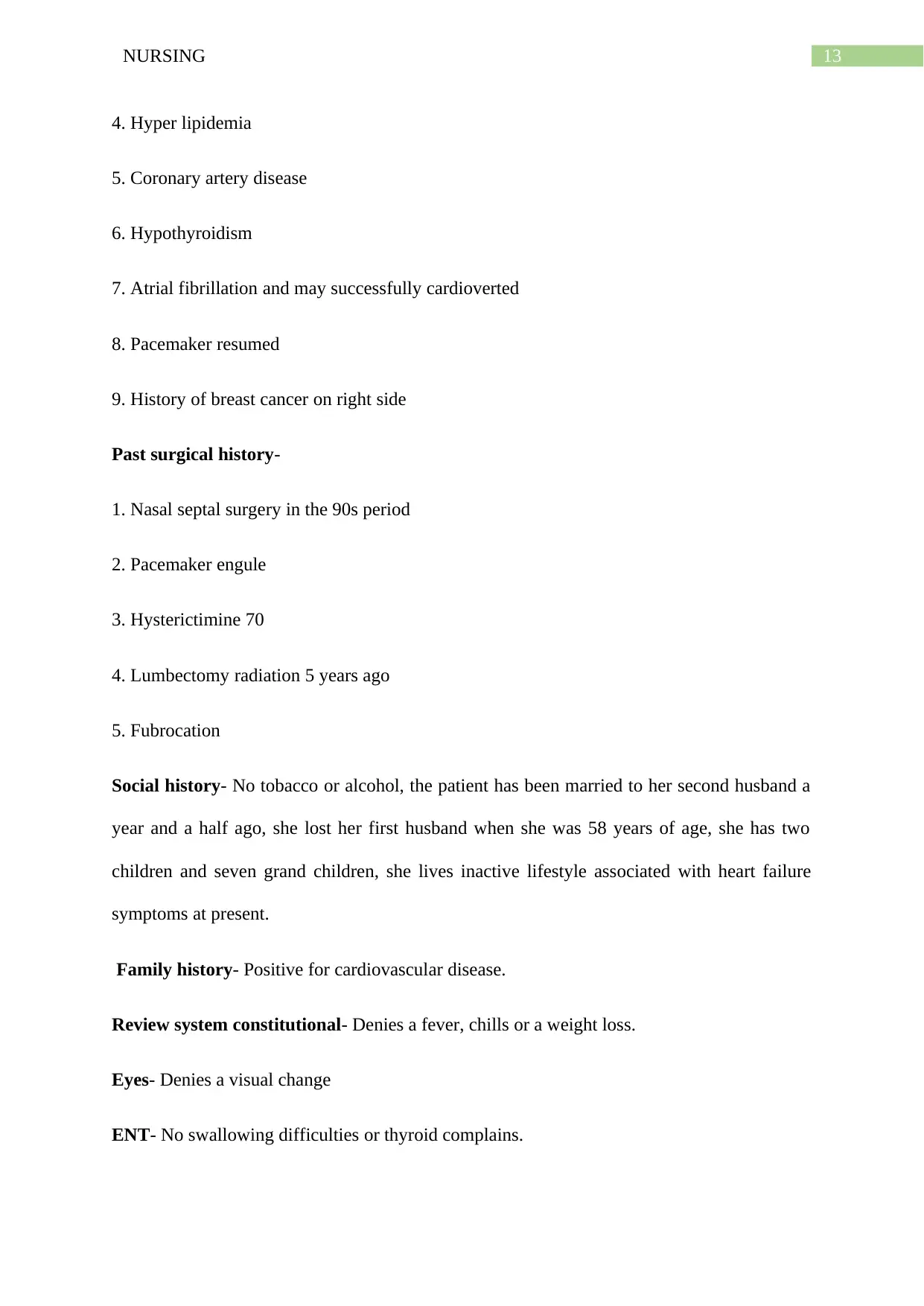
13NURSING
4. Hyper lipidemia
5. Coronary artery disease
6. Hypothyroidism
7. Atrial fibrillation and may successfully cardioverted
8. Pacemaker resumed
9. History of breast cancer on right side
Past surgical history-
1. Nasal septal surgery in the 90s period
2. Pacemaker engule
3. Hysterictimine 70
4. Lumbectomy radiation 5 years ago
5. Fubrocation
Social history- No tobacco or alcohol, the patient has been married to her second husband a
year and a half ago, she lost her first husband when she was 58 years of age, she has two
children and seven grand children, she lives inactive lifestyle associated with heart failure
symptoms at present.
Family history- Positive for cardiovascular disease.
Review system constitutional- Denies a fever, chills or a weight loss.
Eyes- Denies a visual change
ENT- No swallowing difficulties or thyroid complains.
4. Hyper lipidemia
5. Coronary artery disease
6. Hypothyroidism
7. Atrial fibrillation and may successfully cardioverted
8. Pacemaker resumed
9. History of breast cancer on right side
Past surgical history-
1. Nasal septal surgery in the 90s period
2. Pacemaker engule
3. Hysterictimine 70
4. Lumbectomy radiation 5 years ago
5. Fubrocation
Social history- No tobacco or alcohol, the patient has been married to her second husband a
year and a half ago, she lost her first husband when she was 58 years of age, she has two
children and seven grand children, she lives inactive lifestyle associated with heart failure
symptoms at present.
Family history- Positive for cardiovascular disease.
Review system constitutional- Denies a fever, chills or a weight loss.
Eyes- Denies a visual change
ENT- No swallowing difficulties or thyroid complains.
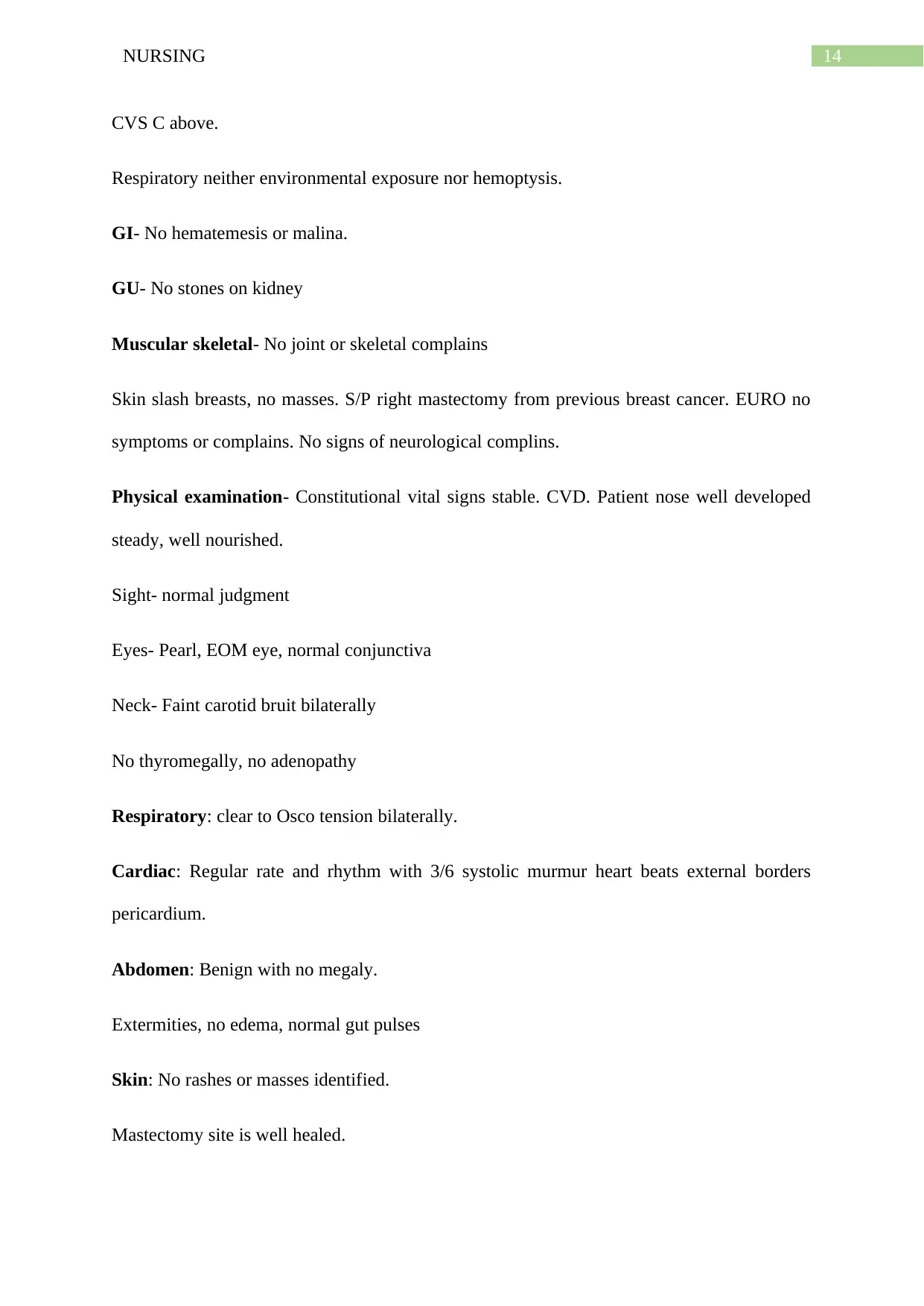
14NURSING
CVS C above.
Respiratory neither environmental exposure nor hemoptysis.
GI- No hematemesis or malina.
GU- No stones on kidney
Muscular skeletal- No joint or skeletal complains
Skin slash breasts, no masses. S/P right mastectomy from previous breast cancer. EURO no
symptoms or complains. No signs of neurological complins.
Physical examination- Constitutional vital signs stable. CVD. Patient nose well developed
steady, well nourished.
Sight- normal judgment
Eyes- Pearl, EOM eye, normal conjunctiva
Neck- Faint carotid bruit bilaterally
No thyromegally, no adenopathy
Respiratory: clear to Osco tension bilaterally.
Cardiac: Regular rate and rhythm with 3/6 systolic murmur heart beats external borders
pericardium.
Abdomen: Benign with no megaly.
Extermities, no edema, normal gut pulses
Skin: No rashes or masses identified.
Mastectomy site is well healed.
CVS C above.
Respiratory neither environmental exposure nor hemoptysis.
GI- No hematemesis or malina.
GU- No stones on kidney
Muscular skeletal- No joint or skeletal complains
Skin slash breasts, no masses. S/P right mastectomy from previous breast cancer. EURO no
symptoms or complains. No signs of neurological complins.
Physical examination- Constitutional vital signs stable. CVD. Patient nose well developed
steady, well nourished.
Sight- normal judgment
Eyes- Pearl, EOM eye, normal conjunctiva
Neck- Faint carotid bruit bilaterally
No thyromegally, no adenopathy
Respiratory: clear to Osco tension bilaterally.
Cardiac: Regular rate and rhythm with 3/6 systolic murmur heart beats external borders
pericardium.
Abdomen: Benign with no megaly.
Extermities, no edema, normal gut pulses
Skin: No rashes or masses identified.
Mastectomy site is well healed.
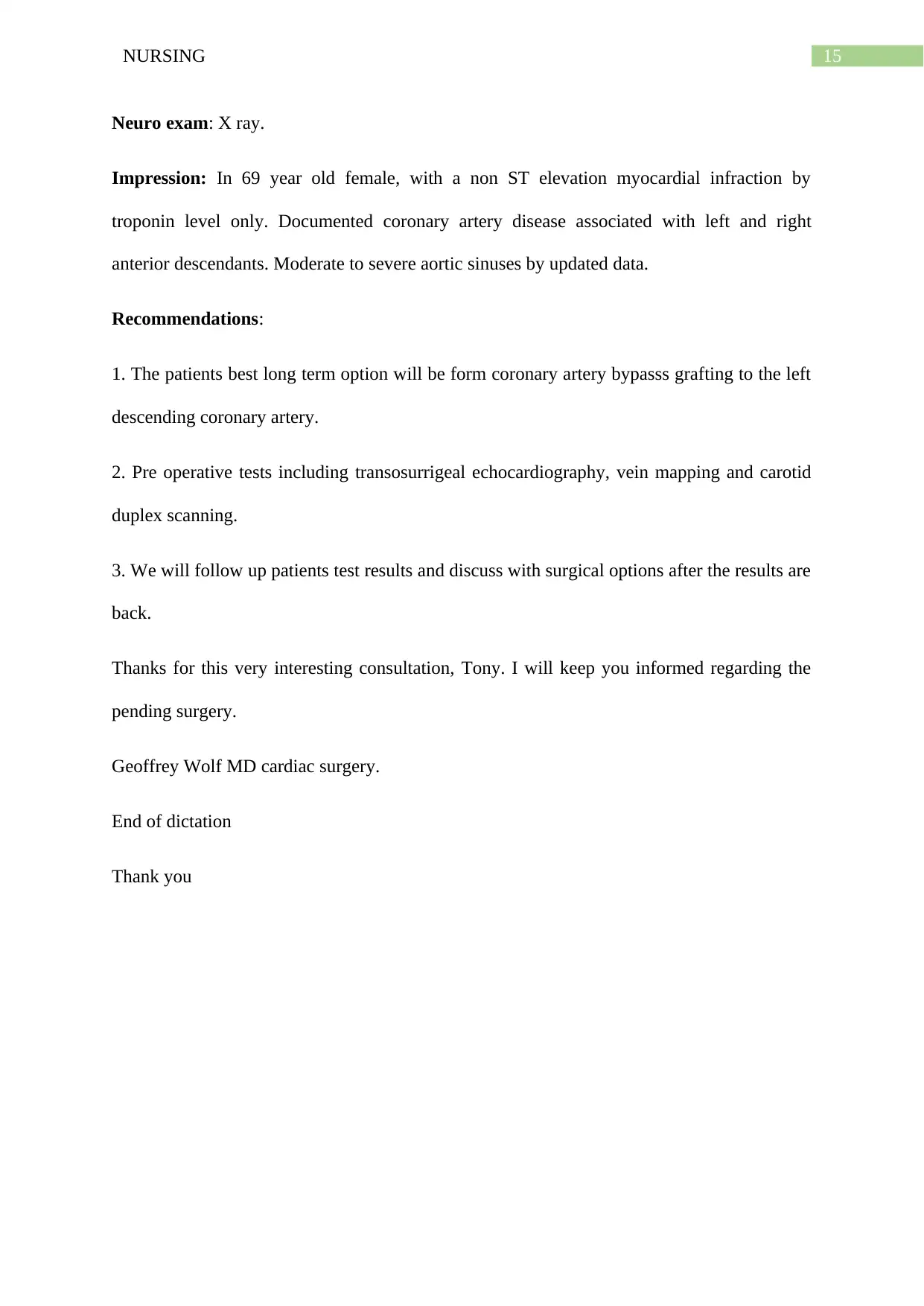
15NURSING
Neuro exam: X ray.
Impression: In 69 year old female, with a non ST elevation myocardial infraction by
troponin level only. Documented coronary artery disease associated with left and right
anterior descendants. Moderate to severe aortic sinuses by updated data.
Recommendations:
1. The patients best long term option will be form coronary artery bypasss grafting to the left
descending coronary artery.
2. Pre operative tests including transosurrigeal echocardiography, vein mapping and carotid
duplex scanning.
3. We will follow up patients test results and discuss with surgical options after the results are
back.
Thanks for this very interesting consultation, Tony. I will keep you informed regarding the
pending surgery.
Geoffrey Wolf MD cardiac surgery.
End of dictation
Thank you
Neuro exam: X ray.
Impression: In 69 year old female, with a non ST elevation myocardial infraction by
troponin level only. Documented coronary artery disease associated with left and right
anterior descendants. Moderate to severe aortic sinuses by updated data.
Recommendations:
1. The patients best long term option will be form coronary artery bypasss grafting to the left
descending coronary artery.
2. Pre operative tests including transosurrigeal echocardiography, vein mapping and carotid
duplex scanning.
3. We will follow up patients test results and discuss with surgical options after the results are
back.
Thanks for this very interesting consultation, Tony. I will keep you informed regarding the
pending surgery.
Geoffrey Wolf MD cardiac surgery.
End of dictation
Thank you
Secure Best Marks with AI Grader
Need help grading? Try our AI Grader for instant feedback on your assignments.
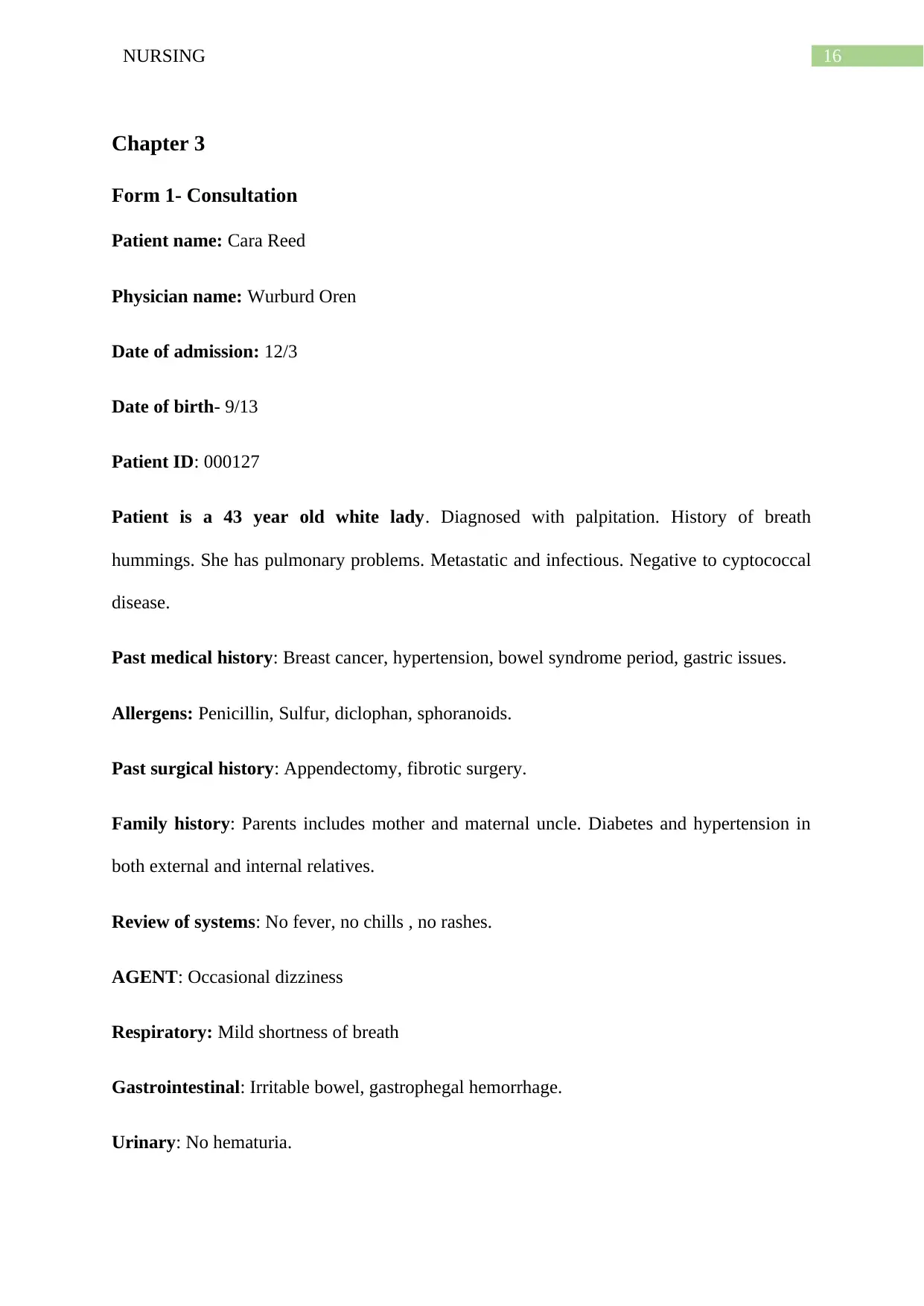
16NURSING
Chapter 3
Form 1- Consultation
Patient name: Cara Reed
Physician name: Wurburd Oren
Date of admission: 12/3
Date of birth- 9/13
Patient ID: 000127
Patient is a 43 year old white lady. Diagnosed with palpitation. History of breath
hummings. She has pulmonary problems. Metastatic and infectious. Negative to cyptococcal
disease.
Past medical history: Breast cancer, hypertension, bowel syndrome period, gastric issues.
Allergens: Penicillin, Sulfur, diclophan, sphoranoids.
Past surgical history: Appendectomy, fibrotic surgery.
Family history: Parents includes mother and maternal uncle. Diabetes and hypertension in
both external and internal relatives.
Review of systems: No fever, no chills , no rashes.
AGENT: Occasional dizziness
Respiratory: Mild shortness of breath
Gastrointestinal: Irritable bowel, gastrophegal hemorrhage.
Urinary: No hematuria.
Chapter 3
Form 1- Consultation
Patient name: Cara Reed
Physician name: Wurburd Oren
Date of admission: 12/3
Date of birth- 9/13
Patient ID: 000127
Patient is a 43 year old white lady. Diagnosed with palpitation. History of breath
hummings. She has pulmonary problems. Metastatic and infectious. Negative to cyptococcal
disease.
Past medical history: Breast cancer, hypertension, bowel syndrome period, gastric issues.
Allergens: Penicillin, Sulfur, diclophan, sphoranoids.
Past surgical history: Appendectomy, fibrotic surgery.
Family history: Parents includes mother and maternal uncle. Diabetes and hypertension in
both external and internal relatives.
Review of systems: No fever, no chills , no rashes.
AGENT: Occasional dizziness
Respiratory: Mild shortness of breath
Gastrointestinal: Irritable bowel, gastrophegal hemorrhage.
Urinary: No hematuria.
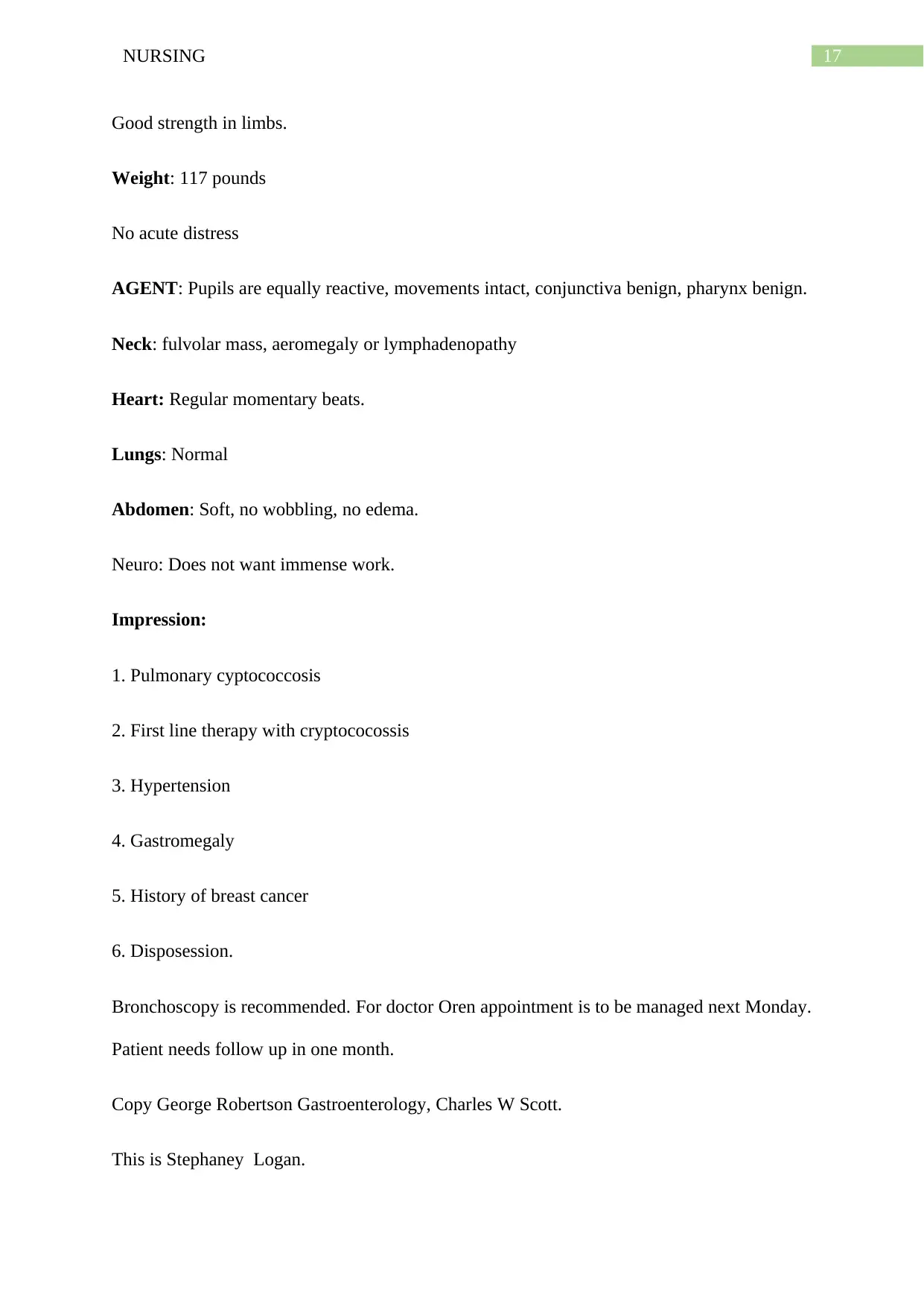
17NURSING
Good strength in limbs.
Weight: 117 pounds
No acute distress
AGENT: Pupils are equally reactive, movements intact, conjunctiva benign, pharynx benign.
Neck: fulvolar mass, aeromegaly or lymphadenopathy
Heart: Regular momentary beats.
Lungs: Normal
Abdomen: Soft, no wobbling, no edema.
Neuro: Does not want immense work.
Impression:
1. Pulmonary cyptococcosis
2. First line therapy with cryptococossis
3. Hypertension
4. Gastromegaly
5. History of breast cancer
6. Disposession.
Bronchoscopy is recommended. For doctor Oren appointment is to be managed next Monday.
Patient needs follow up in one month.
Copy George Robertson Gastroenterology, Charles W Scott.
This is Stephaney Logan.
Good strength in limbs.
Weight: 117 pounds
No acute distress
AGENT: Pupils are equally reactive, movements intact, conjunctiva benign, pharynx benign.
Neck: fulvolar mass, aeromegaly or lymphadenopathy
Heart: Regular momentary beats.
Lungs: Normal
Abdomen: Soft, no wobbling, no edema.
Neuro: Does not want immense work.
Impression:
1. Pulmonary cyptococcosis
2. First line therapy with cryptococossis
3. Hypertension
4. Gastromegaly
5. History of breast cancer
6. Disposession.
Bronchoscopy is recommended. For doctor Oren appointment is to be managed next Monday.
Patient needs follow up in one month.
Copy George Robertson Gastroenterology, Charles W Scott.
This is Stephaney Logan.
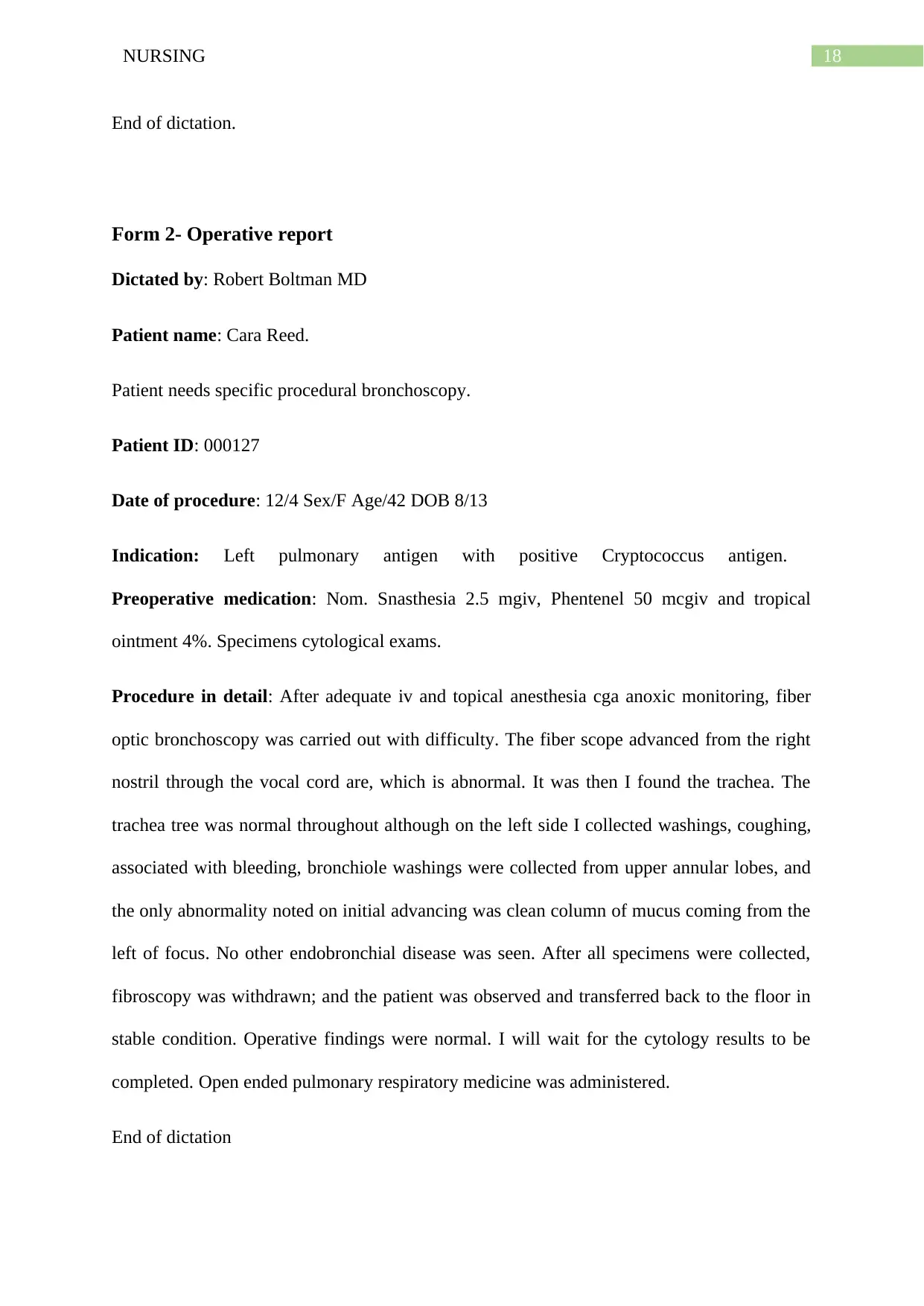
18NURSING
End of dictation.
Form 2- Operative report
Dictated by: Robert Boltman MD
Patient name: Cara Reed.
Patient needs specific procedural bronchoscopy.
Patient ID: 000127
Date of procedure: 12/4 Sex/F Age/42 DOB 8/13
Indication: Left pulmonary antigen with positive Cryptococcus antigen.
Preoperative medication: Nom. Snasthesia 2.5 mgiv, Phentenel 50 mcgiv and tropical
ointment 4%. Specimens cytological exams.
Procedure in detail: After adequate iv and topical anesthesia cga anoxic monitoring, fiber
optic bronchoscopy was carried out with difficulty. The fiber scope advanced from the right
nostril through the vocal cord are, which is abnormal. It was then I found the trachea. The
trachea tree was normal throughout although on the left side I collected washings, coughing,
associated with bleeding, bronchiole washings were collected from upper annular lobes, and
the only abnormality noted on initial advancing was clean column of mucus coming from the
left of focus. No other endobronchial disease was seen. After all specimens were collected,
fibroscopy was withdrawn; and the patient was observed and transferred back to the floor in
stable condition. Operative findings were normal. I will wait for the cytology results to be
completed. Open ended pulmonary respiratory medicine was administered.
End of dictation
End of dictation.
Form 2- Operative report
Dictated by: Robert Boltman MD
Patient name: Cara Reed.
Patient needs specific procedural bronchoscopy.
Patient ID: 000127
Date of procedure: 12/4 Sex/F Age/42 DOB 8/13
Indication: Left pulmonary antigen with positive Cryptococcus antigen.
Preoperative medication: Nom. Snasthesia 2.5 mgiv, Phentenel 50 mcgiv and tropical
ointment 4%. Specimens cytological exams.
Procedure in detail: After adequate iv and topical anesthesia cga anoxic monitoring, fiber
optic bronchoscopy was carried out with difficulty. The fiber scope advanced from the right
nostril through the vocal cord are, which is abnormal. It was then I found the trachea. The
trachea tree was normal throughout although on the left side I collected washings, coughing,
associated with bleeding, bronchiole washings were collected from upper annular lobes, and
the only abnormality noted on initial advancing was clean column of mucus coming from the
left of focus. No other endobronchial disease was seen. After all specimens were collected,
fibroscopy was withdrawn; and the patient was observed and transferred back to the floor in
stable condition. Operative findings were normal. I will wait for the cytology results to be
completed. Open ended pulmonary respiratory medicine was administered.
End of dictation
Paraphrase This Document
Need a fresh take? Get an instant paraphrase of this document with our AI Paraphraser
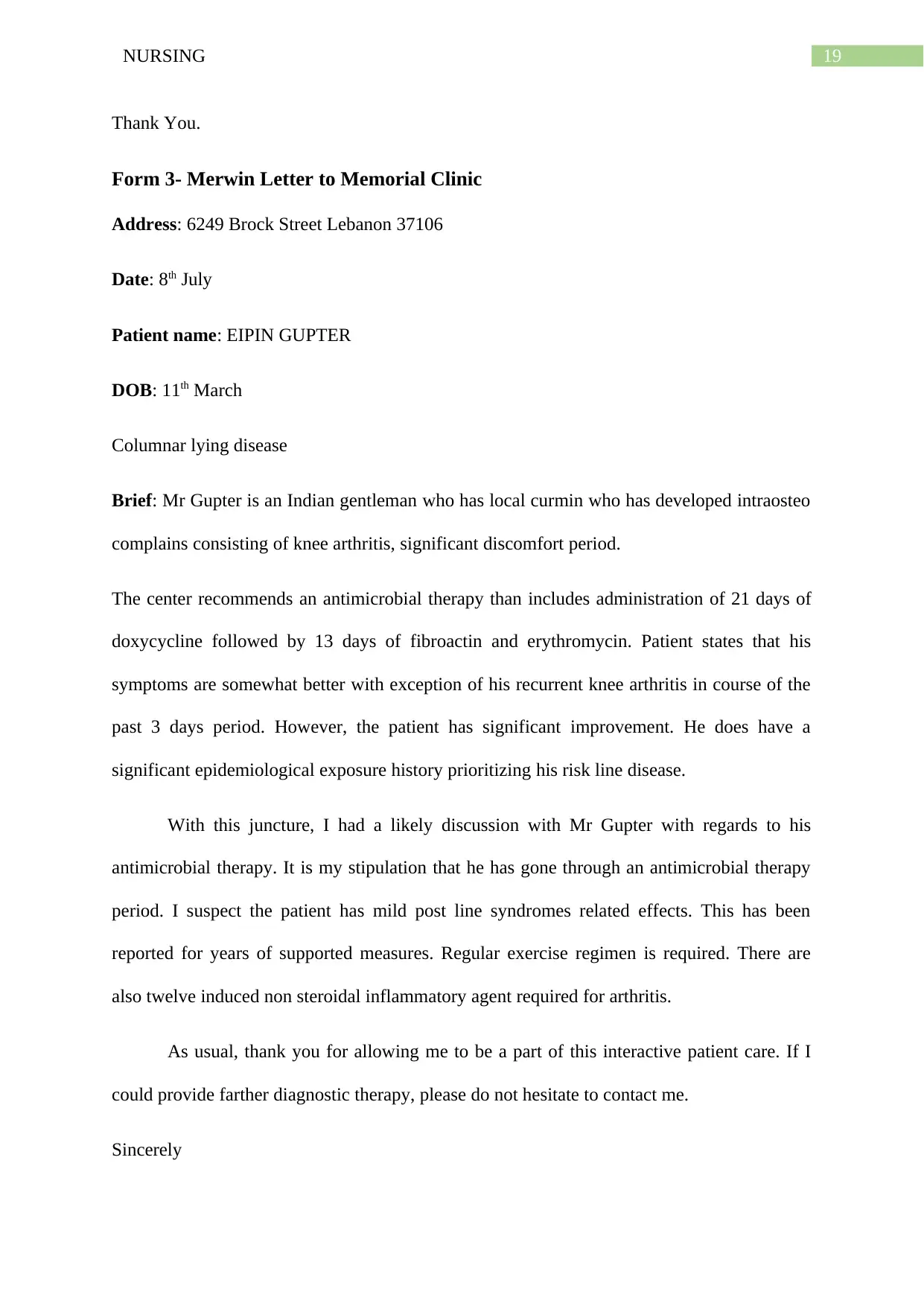
19NURSING
Thank You.
Form 3- Merwin Letter to Memorial Clinic
Address: 6249 Brock Street Lebanon 37106
Date: 8th July
Patient name: EIPIN GUPTER
DOB: 11th March
Columnar lying disease
Brief: Mr Gupter is an Indian gentleman who has local curmin who has developed intraosteo
complains consisting of knee arthritis, significant discomfort period.
The center recommends an antimicrobial therapy than includes administration of 21 days of
doxycycline followed by 13 days of fibroactin and erythromycin. Patient states that his
symptoms are somewhat better with exception of his recurrent knee arthritis in course of the
past 3 days period. However, the patient has significant improvement. He does have a
significant epidemiological exposure history prioritizing his risk line disease.
With this juncture, I had a likely discussion with Mr Gupter with regards to his
antimicrobial therapy. It is my stipulation that he has gone through an antimicrobial therapy
period. I suspect the patient has mild post line syndromes related effects. This has been
reported for years of supported measures. Regular exercise regimen is required. There are
also twelve induced non steroidal inflammatory agent required for arthritis.
As usual, thank you for allowing me to be a part of this interactive patient care. If I
could provide farther diagnostic therapy, please do not hesitate to contact me.
Sincerely
Thank You.
Form 3- Merwin Letter to Memorial Clinic
Address: 6249 Brock Street Lebanon 37106
Date: 8th July
Patient name: EIPIN GUPTER
DOB: 11th March
Columnar lying disease
Brief: Mr Gupter is an Indian gentleman who has local curmin who has developed intraosteo
complains consisting of knee arthritis, significant discomfort period.
The center recommends an antimicrobial therapy than includes administration of 21 days of
doxycycline followed by 13 days of fibroactin and erythromycin. Patient states that his
symptoms are somewhat better with exception of his recurrent knee arthritis in course of the
past 3 days period. However, the patient has significant improvement. He does have a
significant epidemiological exposure history prioritizing his risk line disease.
With this juncture, I had a likely discussion with Mr Gupter with regards to his
antimicrobial therapy. It is my stipulation that he has gone through an antimicrobial therapy
period. I suspect the patient has mild post line syndromes related effects. This has been
reported for years of supported measures. Regular exercise regimen is required. There are
also twelve induced non steroidal inflammatory agent required for arthritis.
As usual, thank you for allowing me to be a part of this interactive patient care. If I
could provide farther diagnostic therapy, please do not hesitate to contact me.
Sincerely
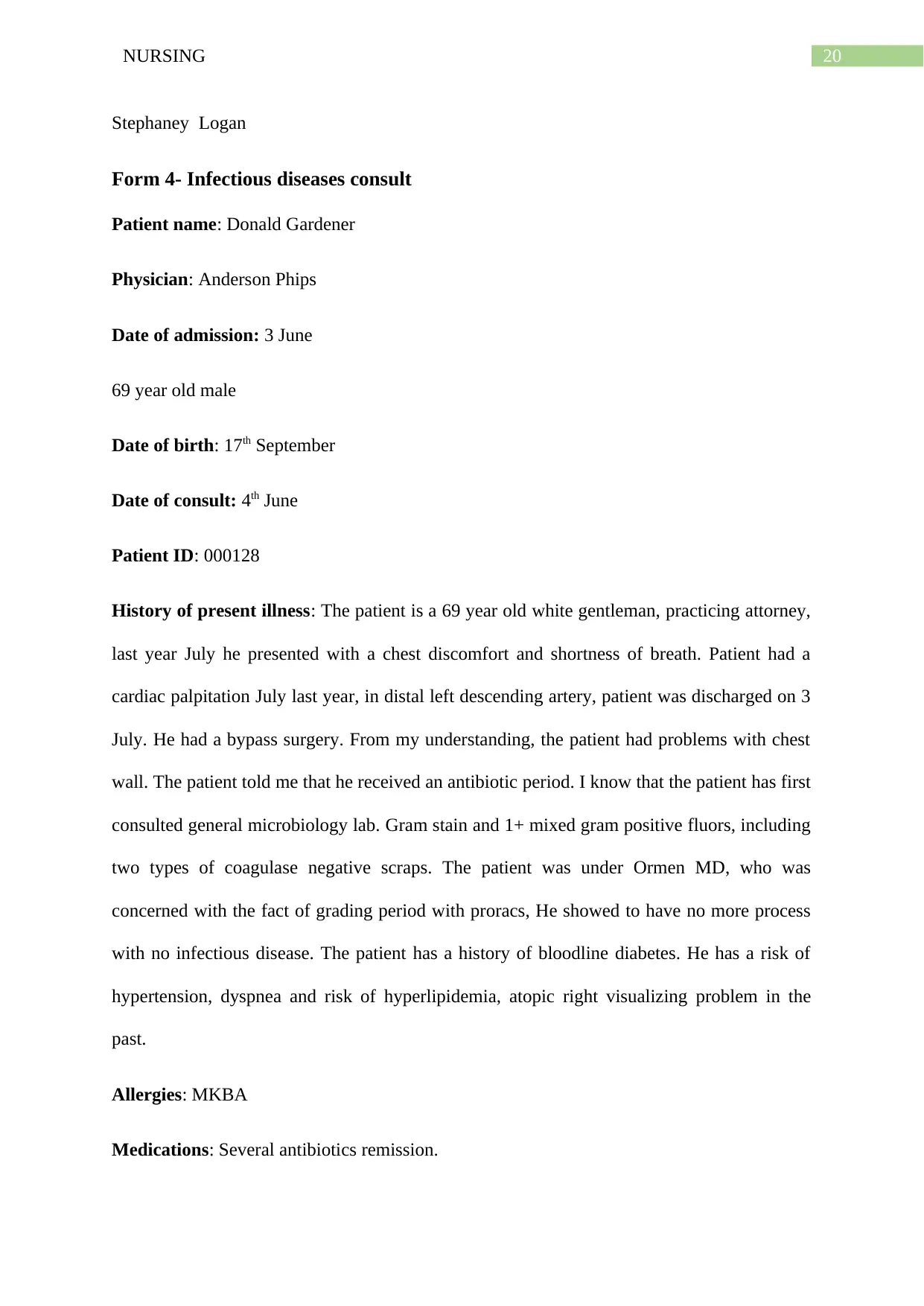
20NURSING
Stephaney Logan
Form 4- Infectious diseases consult
Patient name: Donald Gardener
Physician: Anderson Phips
Date of admission: 3 June
69 year old male
Date of birth: 17th September
Date of consult: 4th June
Patient ID: 000128
History of present illness: The patient is a 69 year old white gentleman, practicing attorney,
last year July he presented with a chest discomfort and shortness of breath. Patient had a
cardiac palpitation July last year, in distal left descending artery, patient was discharged on 3
July. He had a bypass surgery. From my understanding, the patient had problems with chest
wall. The patient told me that he received an antibiotic period. I know that the patient has first
consulted general microbiology lab. Gram stain and 1+ mixed gram positive fluors, including
two types of coagulase negative scraps. The patient was under Ormen MD, who was
concerned with the fact of grading period with proracs, He showed to have no more process
with no infectious disease. The patient has a history of bloodline diabetes. He has a risk of
hypertension, dyspnea and risk of hyperlipidemia, atopic right visualizing problem in the
past.
Allergies: MKBA
Medications: Several antibiotics remission.
Stephaney Logan
Form 4- Infectious diseases consult
Patient name: Donald Gardener
Physician: Anderson Phips
Date of admission: 3 June
69 year old male
Date of birth: 17th September
Date of consult: 4th June
Patient ID: 000128
History of present illness: The patient is a 69 year old white gentleman, practicing attorney,
last year July he presented with a chest discomfort and shortness of breath. Patient had a
cardiac palpitation July last year, in distal left descending artery, patient was discharged on 3
July. He had a bypass surgery. From my understanding, the patient had problems with chest
wall. The patient told me that he received an antibiotic period. I know that the patient has first
consulted general microbiology lab. Gram stain and 1+ mixed gram positive fluors, including
two types of coagulase negative scraps. The patient was under Ormen MD, who was
concerned with the fact of grading period with proracs, He showed to have no more process
with no infectious disease. The patient has a history of bloodline diabetes. He has a risk of
hypertension, dyspnea and risk of hyperlipidemia, atopic right visualizing problem in the
past.
Allergies: MKBA
Medications: Several antibiotics remission.
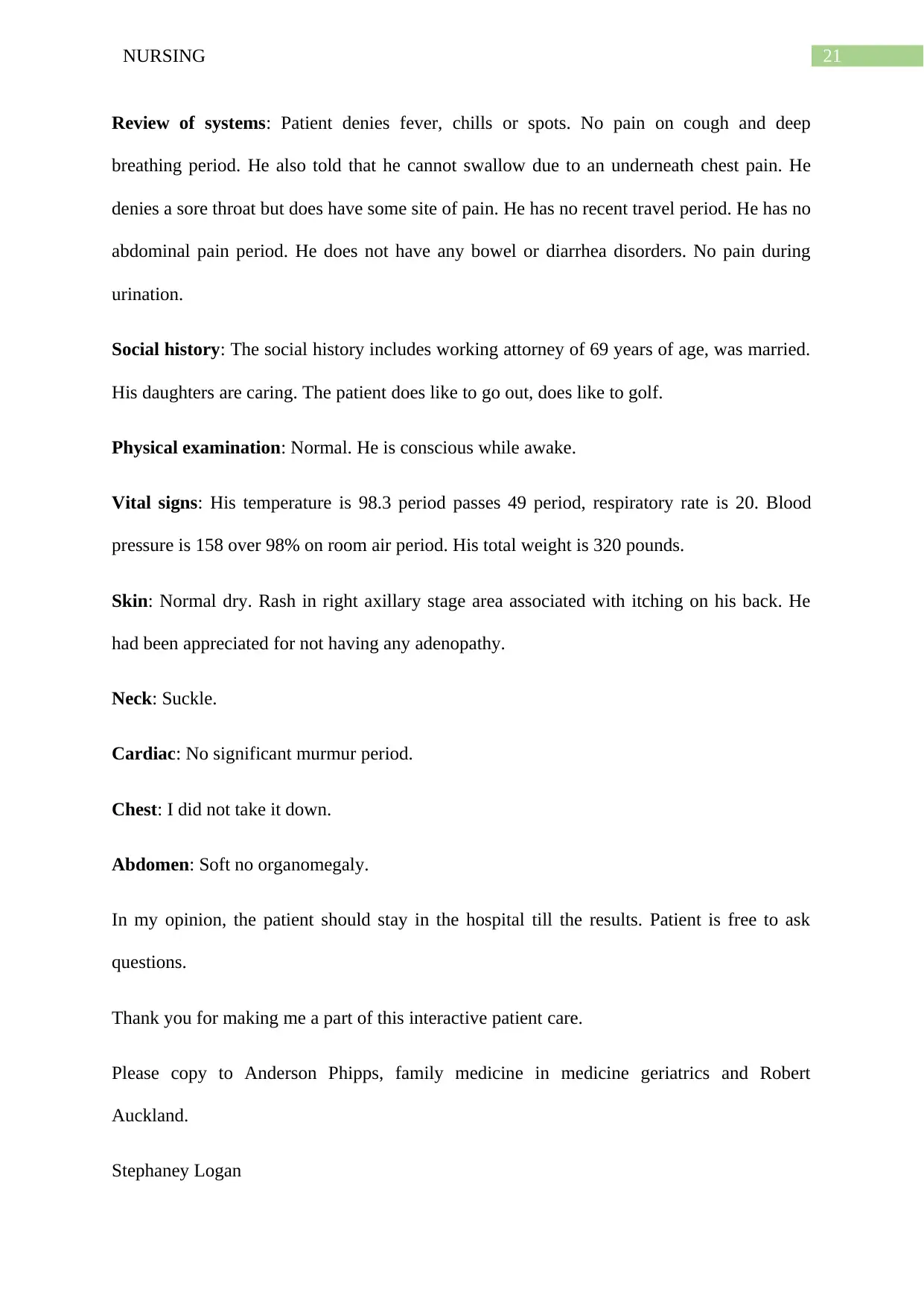
21NURSING
Review of systems: Patient denies fever, chills or spots. No pain on cough and deep
breathing period. He also told that he cannot swallow due to an underneath chest pain. He
denies a sore throat but does have some site of pain. He has no recent travel period. He has no
abdominal pain period. He does not have any bowel or diarrhea disorders. No pain during
urination.
Social history: The social history includes working attorney of 69 years of age, was married.
His daughters are caring. The patient does like to go out, does like to golf.
Physical examination: Normal. He is conscious while awake.
Vital signs: His temperature is 98.3 period passes 49 period, respiratory rate is 20. Blood
pressure is 158 over 98% on room air period. His total weight is 320 pounds.
Skin: Normal dry. Rash in right axillary stage area associated with itching on his back. He
had been appreciated for not having any adenopathy.
Neck: Suckle.
Cardiac: No significant murmur period.
Chest: I did not take it down.
Abdomen: Soft no organomegaly.
In my opinion, the patient should stay in the hospital till the results. Patient is free to ask
questions.
Thank you for making me a part of this interactive patient care.
Please copy to Anderson Phipps, family medicine in medicine geriatrics and Robert
Auckland.
Stephaney Logan
Review of systems: Patient denies fever, chills or spots. No pain on cough and deep
breathing period. He also told that he cannot swallow due to an underneath chest pain. He
denies a sore throat but does have some site of pain. He has no recent travel period. He has no
abdominal pain period. He does not have any bowel or diarrhea disorders. No pain during
urination.
Social history: The social history includes working attorney of 69 years of age, was married.
His daughters are caring. The patient does like to go out, does like to golf.
Physical examination: Normal. He is conscious while awake.
Vital signs: His temperature is 98.3 period passes 49 period, respiratory rate is 20. Blood
pressure is 158 over 98% on room air period. His total weight is 320 pounds.
Skin: Normal dry. Rash in right axillary stage area associated with itching on his back. He
had been appreciated for not having any adenopathy.
Neck: Suckle.
Cardiac: No significant murmur period.
Chest: I did not take it down.
Abdomen: Soft no organomegaly.
In my opinion, the patient should stay in the hospital till the results. Patient is free to ask
questions.
Thank you for making me a part of this interactive patient care.
Please copy to Anderson Phipps, family medicine in medicine geriatrics and Robert
Auckland.
Stephaney Logan
Secure Best Marks with AI Grader
Need help grading? Try our AI Grader for instant feedback on your assignments.
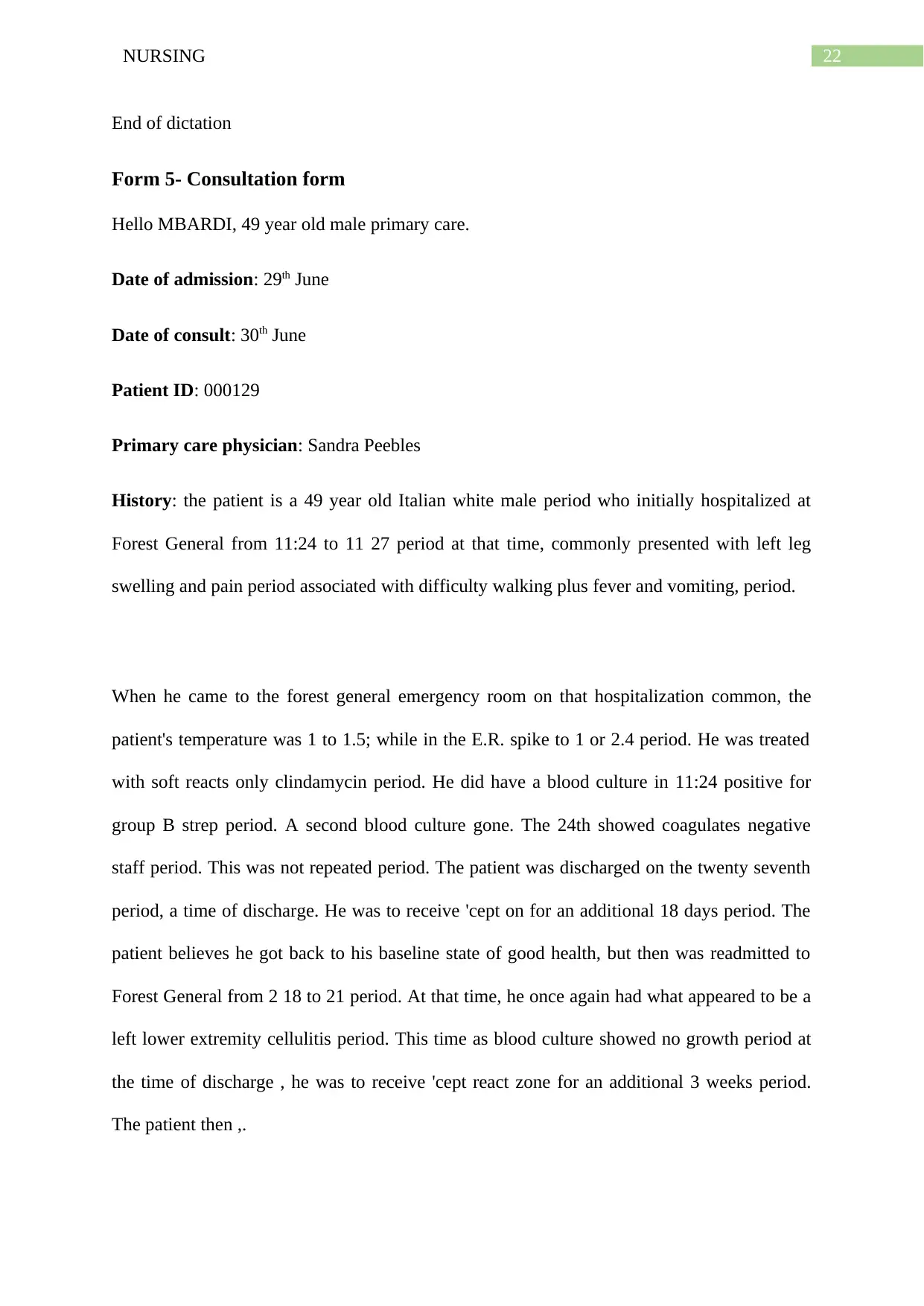
22NURSING
End of dictation
Form 5- Consultation form
Hello MBARDI, 49 year old male primary care.
Date of admission: 29th June
Date of consult: 30th June
Patient ID: 000129
Primary care physician: Sandra Peebles
History: the patient is a 49 year old Italian white male period who initially hospitalized at
Forest General from 11:24 to 11 27 period at that time, commonly presented with left leg
swelling and pain period associated with difficulty walking plus fever and vomiting, period.
When he came to the forest general emergency room on that hospitalization common, the
patient's temperature was 1 to 1.5; while in the E.R. spike to 1 or 2.4 period. He was treated
with soft reacts only clindamycin period. He did have a blood culture in 11:24 positive for
group B strep period. A second blood culture gone. The 24th showed coagulates negative
staff period. This was not repeated period. The patient was discharged on the twenty seventh
period, a time of discharge. He was to receive 'cept on for an additional 18 days period. The
patient believes he got back to his baseline state of good health, but then was readmitted to
Forest General from 2 18 to 21 period. At that time, he once again had what appeared to be a
left lower extremity cellulitis period. This time as blood culture showed no growth period at
the time of discharge , he was to receive 'cept react zone for an additional 3 weeks period.
The patient then ,.
End of dictation
Form 5- Consultation form
Hello MBARDI, 49 year old male primary care.
Date of admission: 29th June
Date of consult: 30th June
Patient ID: 000129
Primary care physician: Sandra Peebles
History: the patient is a 49 year old Italian white male period who initially hospitalized at
Forest General from 11:24 to 11 27 period at that time, commonly presented with left leg
swelling and pain period associated with difficulty walking plus fever and vomiting, period.
When he came to the forest general emergency room on that hospitalization common, the
patient's temperature was 1 to 1.5; while in the E.R. spike to 1 or 2.4 period. He was treated
with soft reacts only clindamycin period. He did have a blood culture in 11:24 positive for
group B strep period. A second blood culture gone. The 24th showed coagulates negative
staff period. This was not repeated period. The patient was discharged on the twenty seventh
period, a time of discharge. He was to receive 'cept on for an additional 18 days period. The
patient believes he got back to his baseline state of good health, but then was readmitted to
Forest General from 2 18 to 21 period. At that time, he once again had what appeared to be a
left lower extremity cellulitis period. This time as blood culture showed no growth period at
the time of discharge , he was to receive 'cept react zone for an additional 3 weeks period.
The patient then ,.
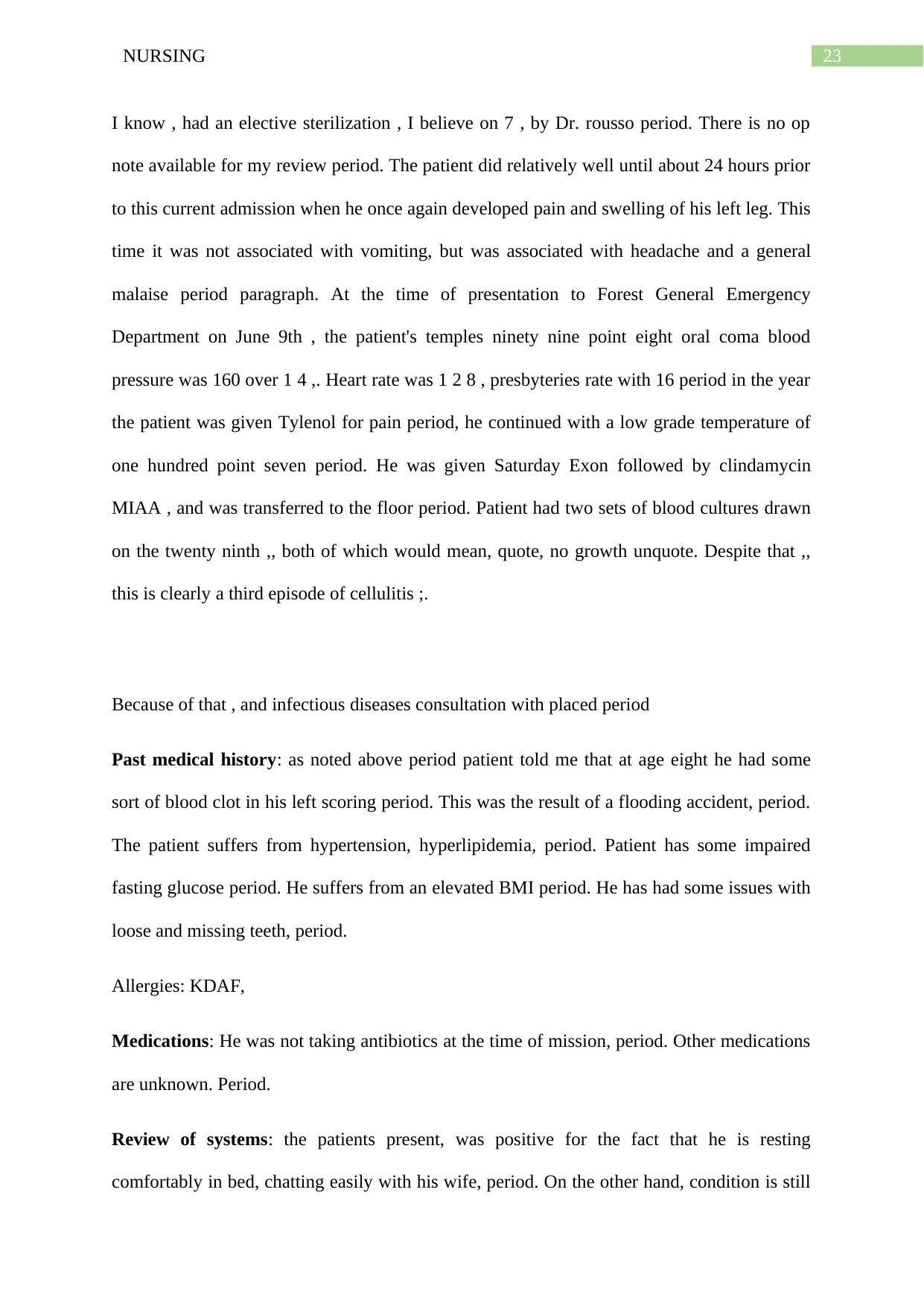
23NURSING
I know , had an elective sterilization , I believe on 7 , by Dr. rousso period. There is no op
note available for my review period. The patient did relatively well until about 24 hours prior
to this current admission when he once again developed pain and swelling of his left leg. This
time it was not associated with vomiting, but was associated with headache and a general
malaise period paragraph. At the time of presentation to Forest General Emergency
Department on June 9th , the patient's temples ninety nine point eight oral coma blood
pressure was 160 over 1 4 ,. Heart rate was 1 2 8 , presbyteries rate with 16 period in the year
the patient was given Tylenol for pain period, he continued with a low grade temperature of
one hundred point seven period. He was given Saturday Exon followed by clindamycin
MIAA , and was transferred to the floor period. Patient had two sets of blood cultures drawn
on the twenty ninth ,, both of which would mean, quote, no growth unquote. Despite that ,,
this is clearly a third episode of cellulitis ;.
Because of that , and infectious diseases consultation with placed period
Past medical history: as noted above period patient told me that at age eight he had some
sort of blood clot in his left scoring period. This was the result of a flooding accident, period.
The patient suffers from hypertension, hyperlipidemia, period. Patient has some impaired
fasting glucose period. He suffers from an elevated BMI period. He has had some issues with
loose and missing teeth, period.
Allergies: KDAF,
Medications: He was not taking antibiotics at the time of mission, period. Other medications
are unknown. Period.
Review of systems: the patients present, was positive for the fact that he is resting
comfortably in bed, chatting easily with his wife, period. On the other hand, condition is still
I know , had an elective sterilization , I believe on 7 , by Dr. rousso period. There is no op
note available for my review period. The patient did relatively well until about 24 hours prior
to this current admission when he once again developed pain and swelling of his left leg. This
time it was not associated with vomiting, but was associated with headache and a general
malaise period paragraph. At the time of presentation to Forest General Emergency
Department on June 9th , the patient's temples ninety nine point eight oral coma blood
pressure was 160 over 1 4 ,. Heart rate was 1 2 8 , presbyteries rate with 16 period in the year
the patient was given Tylenol for pain period, he continued with a low grade temperature of
one hundred point seven period. He was given Saturday Exon followed by clindamycin
MIAA , and was transferred to the floor period. Patient had two sets of blood cultures drawn
on the twenty ninth ,, both of which would mean, quote, no growth unquote. Despite that ,,
this is clearly a third episode of cellulitis ;.
Because of that , and infectious diseases consultation with placed period
Past medical history: as noted above period patient told me that at age eight he had some
sort of blood clot in his left scoring period. This was the result of a flooding accident, period.
The patient suffers from hypertension, hyperlipidemia, period. Patient has some impaired
fasting glucose period. He suffers from an elevated BMI period. He has had some issues with
loose and missing teeth, period.
Allergies: KDAF,
Medications: He was not taking antibiotics at the time of mission, period. Other medications
are unknown. Period.
Review of systems: the patients present, was positive for the fact that he is resting
comfortably in bed, chatting easily with his wife, period. On the other hand, condition is still
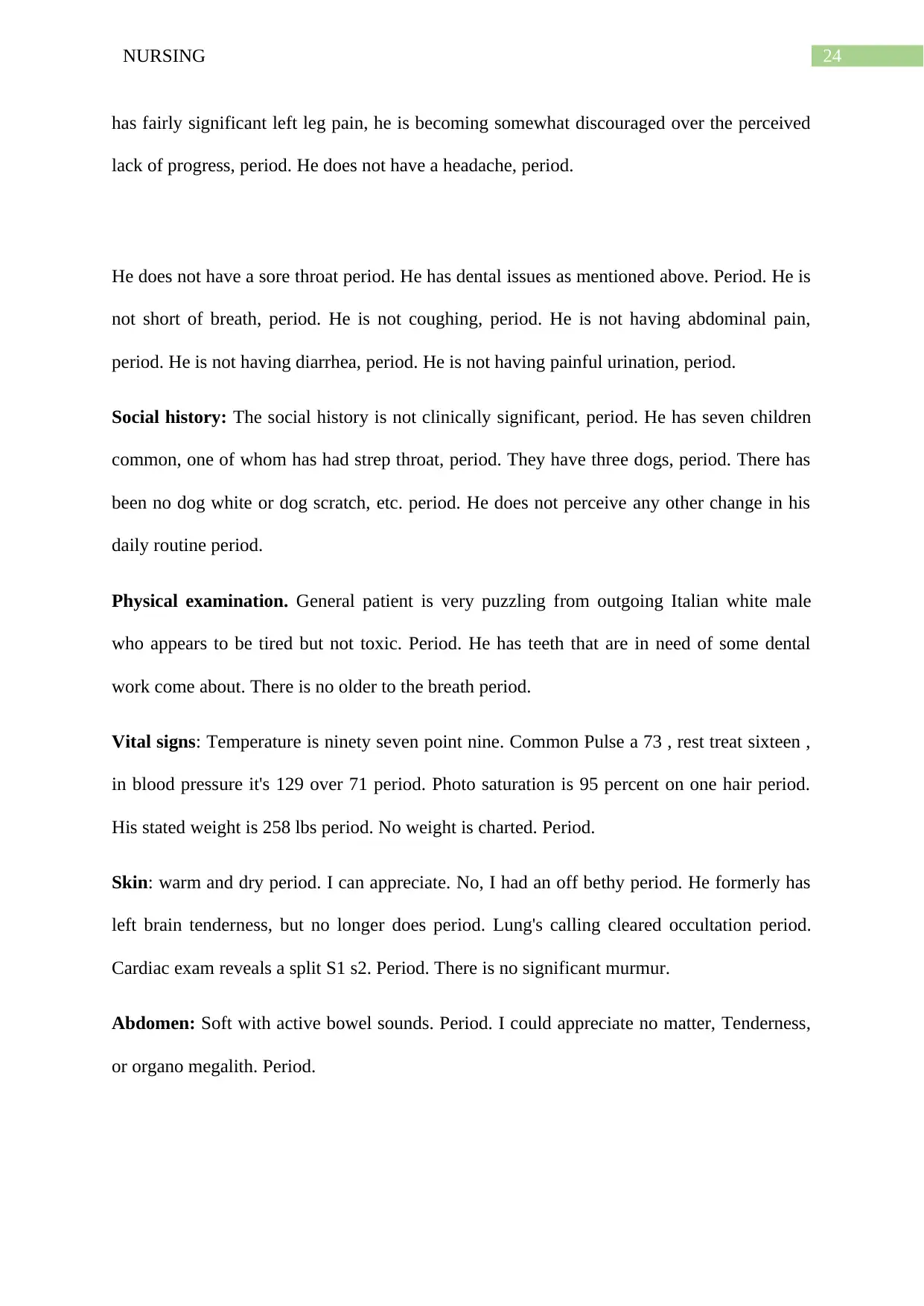
24NURSING
has fairly significant left leg pain, he is becoming somewhat discouraged over the perceived
lack of progress, period. He does not have a headache, period.
He does not have a sore throat period. He has dental issues as mentioned above. Period. He is
not short of breath, period. He is not coughing, period. He is not having abdominal pain,
period. He is not having diarrhea, period. He is not having painful urination, period.
Social history: The social history is not clinically significant, period. He has seven children
common, one of whom has had strep throat, period. They have three dogs, period. There has
been no dog white or dog scratch, etc. period. He does not perceive any other change in his
daily routine period.
Physical examination. General patient is very puzzling from outgoing Italian white male
who appears to be tired but not toxic. Period. He has teeth that are in need of some dental
work come about. There is no older to the breath period.
Vital signs: Temperature is ninety seven point nine. Common Pulse a 73 , rest treat sixteen ,
in blood pressure it's 129 over 71 period. Photo saturation is 95 percent on one hair period.
His stated weight is 258 lbs period. No weight is charted. Period.
Skin: warm and dry period. I can appreciate. No, I had an off bethy period. He formerly has
left brain tenderness, but no longer does period. Lung's calling cleared occultation period.
Cardiac exam reveals a split S1 s2. Period. There is no significant murmur.
Abdomen: Soft with active bowel sounds. Period. I could appreciate no matter, Tenderness,
or organo megalith. Period.
has fairly significant left leg pain, he is becoming somewhat discouraged over the perceived
lack of progress, period. He does not have a headache, period.
He does not have a sore throat period. He has dental issues as mentioned above. Period. He is
not short of breath, period. He is not coughing, period. He is not having abdominal pain,
period. He is not having diarrhea, period. He is not having painful urination, period.
Social history: The social history is not clinically significant, period. He has seven children
common, one of whom has had strep throat, period. They have three dogs, period. There has
been no dog white or dog scratch, etc. period. He does not perceive any other change in his
daily routine period.
Physical examination. General patient is very puzzling from outgoing Italian white male
who appears to be tired but not toxic. Period. He has teeth that are in need of some dental
work come about. There is no older to the breath period.
Vital signs: Temperature is ninety seven point nine. Common Pulse a 73 , rest treat sixteen ,
in blood pressure it's 129 over 71 period. Photo saturation is 95 percent on one hair period.
His stated weight is 258 lbs period. No weight is charted. Period.
Skin: warm and dry period. I can appreciate. No, I had an off bethy period. He formerly has
left brain tenderness, but no longer does period. Lung's calling cleared occultation period.
Cardiac exam reveals a split S1 s2. Period. There is no significant murmur.
Abdomen: Soft with active bowel sounds. Period. I could appreciate no matter, Tenderness,
or organo megalith. Period.
Paraphrase This Document
Need a fresh take? Get an instant paraphrase of this document with our AI Paraphraser
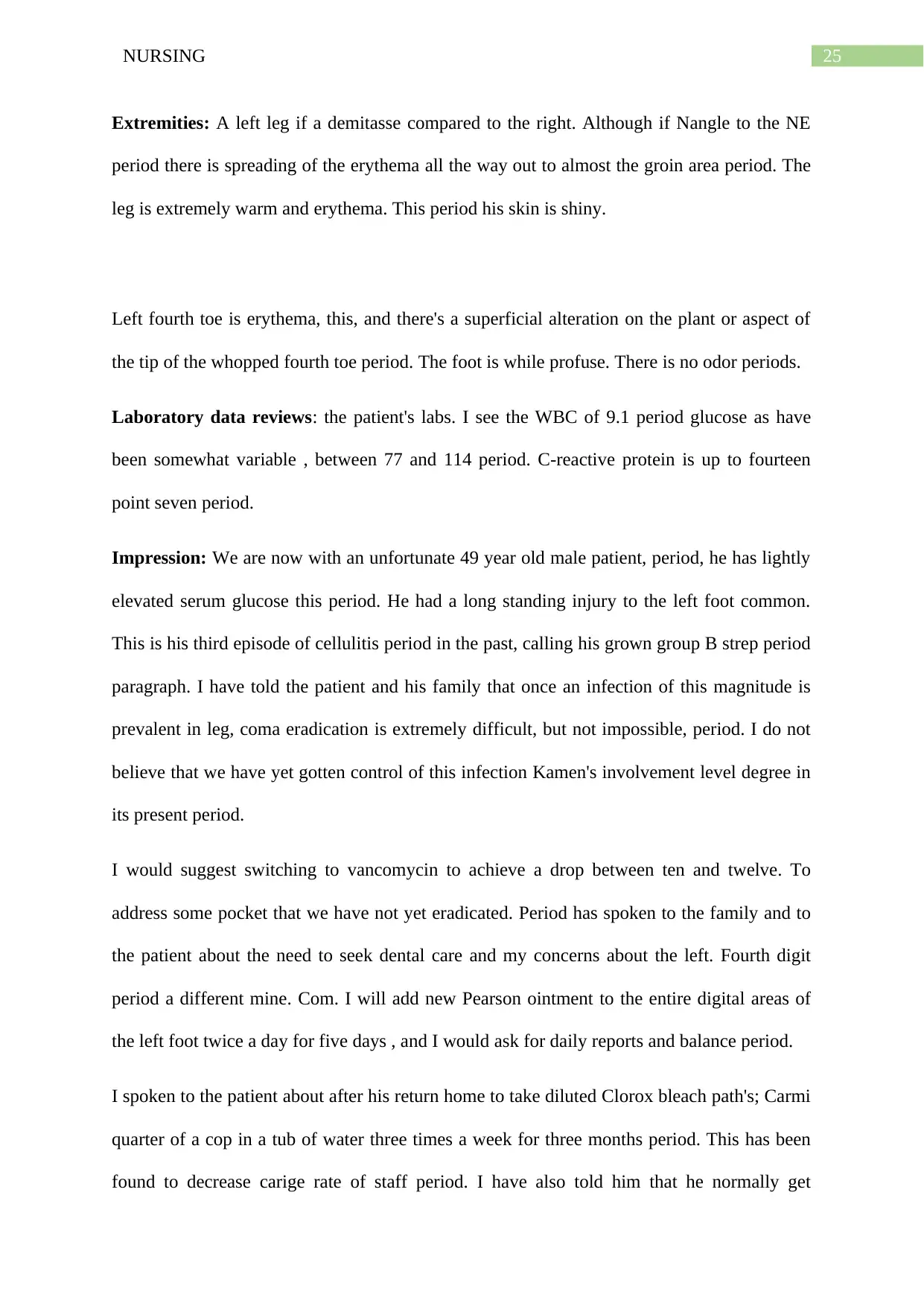
25NURSING
Extremities: A left leg if a demitasse compared to the right. Although if Nangle to the NE
period there is spreading of the erythema all the way out to almost the groin area period. The
leg is extremely warm and erythema. This period his skin is shiny.
Left fourth toe is erythema, this, and there's a superficial alteration on the plant or aspect of
the tip of the whopped fourth toe period. The foot is while profuse. There is no odor periods.
Laboratory data reviews: the patient's labs. I see the WBC of 9.1 period glucose as have
been somewhat variable , between 77 and 114 period. C-reactive protein is up to fourteen
point seven period.
Impression: We are now with an unfortunate 49 year old male patient, period, he has lightly
elevated serum glucose this period. He had a long standing injury to the left foot common.
This is his third episode of cellulitis period in the past, calling his grown group B strep period
paragraph. I have told the patient and his family that once an infection of this magnitude is
prevalent in leg, coma eradication is extremely difficult, but not impossible, period. I do not
believe that we have yet gotten control of this infection Kamen's involvement level degree in
its present period.
I would suggest switching to vancomycin to achieve a drop between ten and twelve. To
address some pocket that we have not yet eradicated. Period has spoken to the family and to
the patient about the need to seek dental care and my concerns about the left. Fourth digit
period a different mine. Com. I will add new Pearson ointment to the entire digital areas of
the left foot twice a day for five days , and I would ask for daily reports and balance period.
I spoken to the patient about after his return home to take diluted Clorox bleach path's; Carmi
quarter of a cop in a tub of water three times a week for three months period. This has been
found to decrease carige rate of staff period. I have also told him that he normally get
Extremities: A left leg if a demitasse compared to the right. Although if Nangle to the NE
period there is spreading of the erythema all the way out to almost the groin area period. The
leg is extremely warm and erythema. This period his skin is shiny.
Left fourth toe is erythema, this, and there's a superficial alteration on the plant or aspect of
the tip of the whopped fourth toe period. The foot is while profuse. There is no odor periods.
Laboratory data reviews: the patient's labs. I see the WBC of 9.1 period glucose as have
been somewhat variable , between 77 and 114 period. C-reactive protein is up to fourteen
point seven period.
Impression: We are now with an unfortunate 49 year old male patient, period, he has lightly
elevated serum glucose this period. He had a long standing injury to the left foot common.
This is his third episode of cellulitis period in the past, calling his grown group B strep period
paragraph. I have told the patient and his family that once an infection of this magnitude is
prevalent in leg, coma eradication is extremely difficult, but not impossible, period. I do not
believe that we have yet gotten control of this infection Kamen's involvement level degree in
its present period.
I would suggest switching to vancomycin to achieve a drop between ten and twelve. To
address some pocket that we have not yet eradicated. Period has spoken to the family and to
the patient about the need to seek dental care and my concerns about the left. Fourth digit
period a different mine. Com. I will add new Pearson ointment to the entire digital areas of
the left foot twice a day for five days , and I would ask for daily reports and balance period.
I spoken to the patient about after his return home to take diluted Clorox bleach path's; Carmi
quarter of a cop in a tub of water three times a week for three months period. This has been
found to decrease carige rate of staff period. I have also told him that he normally get
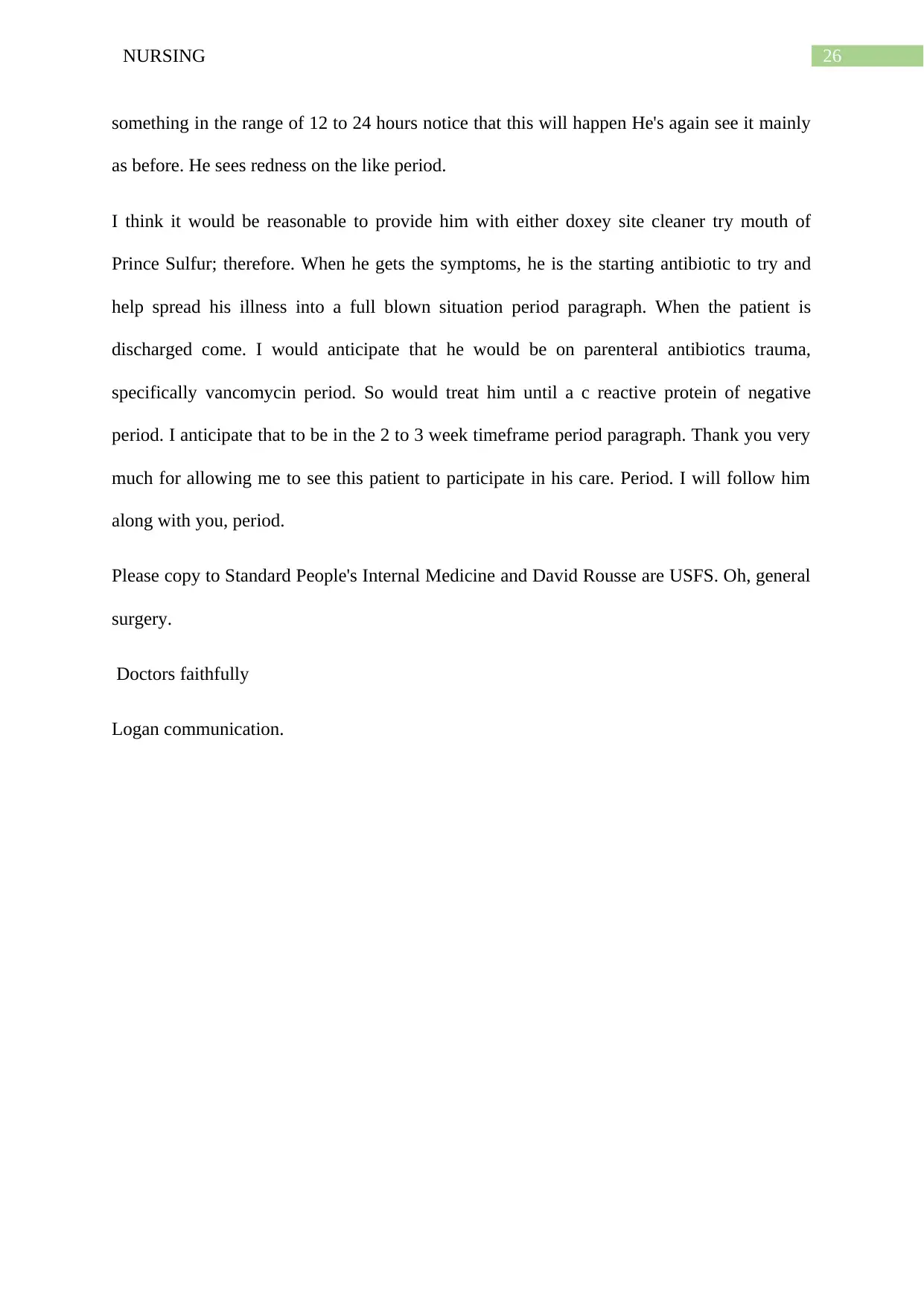
26NURSING
something in the range of 12 to 24 hours notice that this will happen He's again see it mainly
as before. He sees redness on the like period.
I think it would be reasonable to provide him with either doxey site cleaner try mouth of
Prince Sulfur; therefore. When he gets the symptoms, he is the starting antibiotic to try and
help spread his illness into a full blown situation period paragraph. When the patient is
discharged come. I would anticipate that he would be on parenteral antibiotics trauma,
specifically vancomycin period. So would treat him until a c reactive protein of negative
period. I anticipate that to be in the 2 to 3 week timeframe period paragraph. Thank you very
much for allowing me to see this patient to participate in his care. Period. I will follow him
along with you, period.
Please copy to Standard People's Internal Medicine and David Rousse are USFS. Oh, general
surgery.
Doctors faithfully
Logan communication.
something in the range of 12 to 24 hours notice that this will happen He's again see it mainly
as before. He sees redness on the like period.
I think it would be reasonable to provide him with either doxey site cleaner try mouth of
Prince Sulfur; therefore. When he gets the symptoms, he is the starting antibiotic to try and
help spread his illness into a full blown situation period paragraph. When the patient is
discharged come. I would anticipate that he would be on parenteral antibiotics trauma,
specifically vancomycin period. So would treat him until a c reactive protein of negative
period. I anticipate that to be in the 2 to 3 week timeframe period paragraph. Thank you very
much for allowing me to see this patient to participate in his care. Period. I will follow him
along with you, period.
Please copy to Standard People's Internal Medicine and David Rousse are USFS. Oh, general
surgery.
Doctors faithfully
Logan communication.
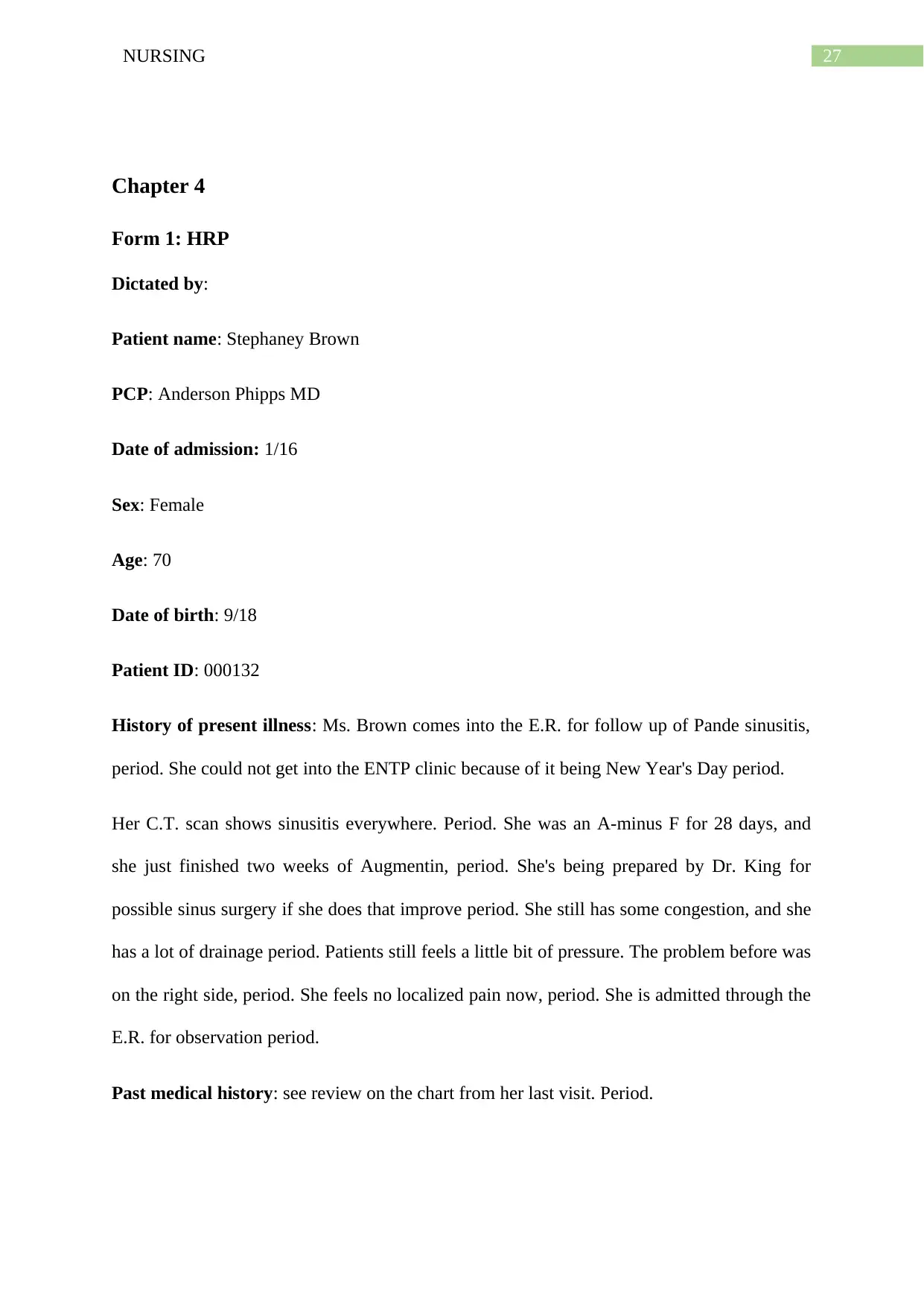
27NURSING
Chapter 4
Form 1: HRP
Dictated by:
Patient name: Stephaney Brown
PCP: Anderson Phipps MD
Date of admission: 1/16
Sex: Female
Age: 70
Date of birth: 9/18
Patient ID: 000132
History of present illness: Ms. Brown comes into the E.R. for follow up of Pande sinusitis,
period. She could not get into the ENTP clinic because of it being New Year's Day period.
Her C.T. scan shows sinusitis everywhere. Period. She was an A-minus F for 28 days, and
she just finished two weeks of Augmentin, period. She's being prepared by Dr. King for
possible sinus surgery if she does that improve period. She still has some congestion, and she
has a lot of drainage period. Patients still feels a little bit of pressure. The problem before was
on the right side, period. She feels no localized pain now, period. She is admitted through the
E.R. for observation period.
Past medical history: see review on the chart from her last visit. Period.
Chapter 4
Form 1: HRP
Dictated by:
Patient name: Stephaney Brown
PCP: Anderson Phipps MD
Date of admission: 1/16
Sex: Female
Age: 70
Date of birth: 9/18
Patient ID: 000132
History of present illness: Ms. Brown comes into the E.R. for follow up of Pande sinusitis,
period. She could not get into the ENTP clinic because of it being New Year's Day period.
Her C.T. scan shows sinusitis everywhere. Period. She was an A-minus F for 28 days, and
she just finished two weeks of Augmentin, period. She's being prepared by Dr. King for
possible sinus surgery if she does that improve period. She still has some congestion, and she
has a lot of drainage period. Patients still feels a little bit of pressure. The problem before was
on the right side, period. She feels no localized pain now, period. She is admitted through the
E.R. for observation period.
Past medical history: see review on the chart from her last visit. Period.
Secure Best Marks with AI Grader
Need help grading? Try our AI Grader for instant feedback on your assignments.
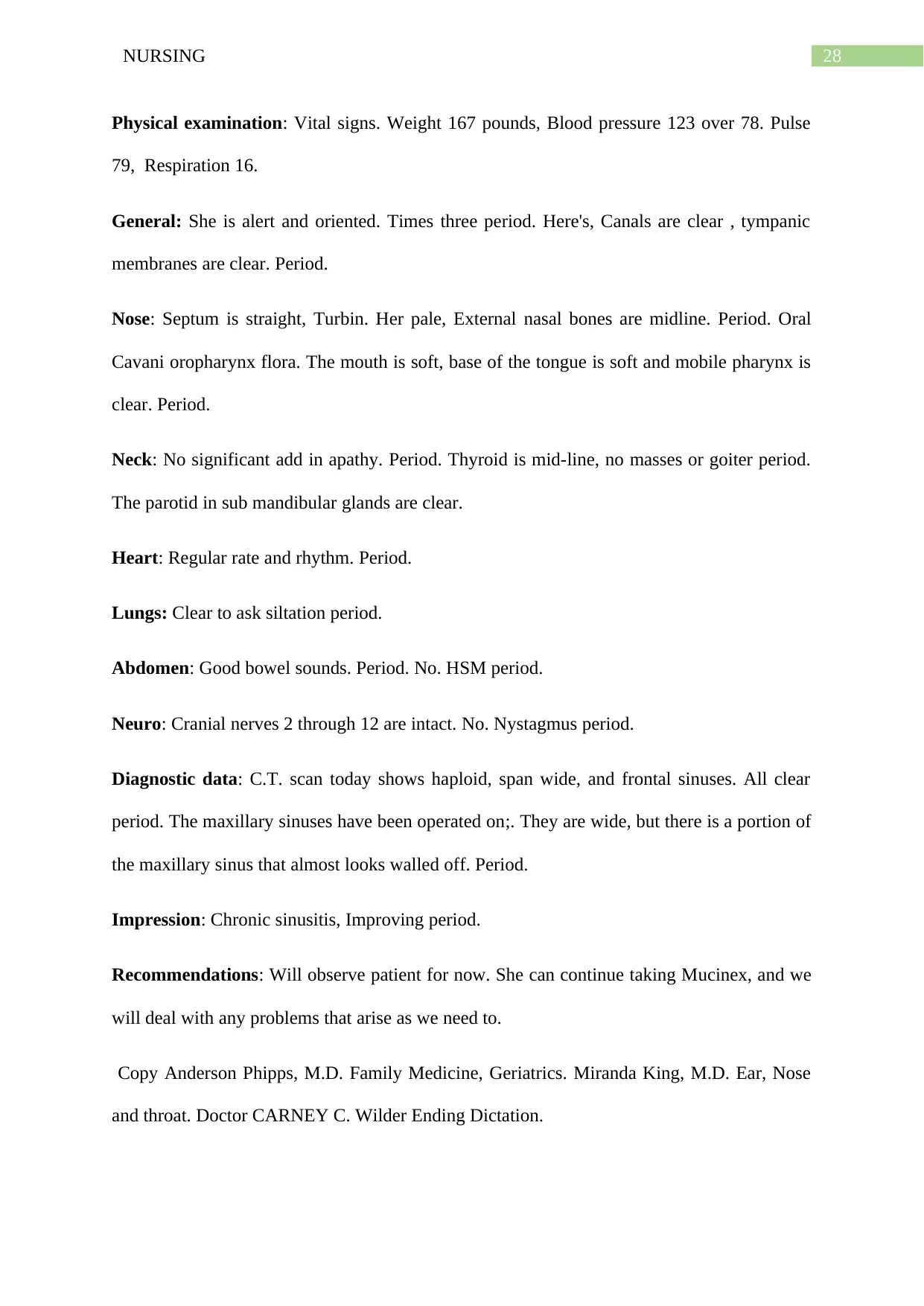
28NURSING
Physical examination: Vital signs. Weight 167 pounds, Blood pressure 123 over 78. Pulse
79, Respiration 16.
General: She is alert and oriented. Times three period. Here's, Canals are clear , tympanic
membranes are clear. Period.
Nose: Septum is straight, Turbin. Her pale, External nasal bones are midline. Period. Oral
Cavani oropharynx flora. The mouth is soft, base of the tongue is soft and mobile pharynx is
clear. Period.
Neck: No significant add in apathy. Period. Thyroid is mid-line, no masses or goiter period.
The parotid in sub mandibular glands are clear.
Heart: Regular rate and rhythm. Period.
Lungs: Clear to ask siltation period.
Abdomen: Good bowel sounds. Period. No. HSM period.
Neuro: Cranial nerves 2 through 12 are intact. No. Nystagmus period.
Diagnostic data: C.T. scan today shows haploid, span wide, and frontal sinuses. All clear
period. The maxillary sinuses have been operated on;. They are wide, but there is a portion of
the maxillary sinus that almost looks walled off. Period.
Impression: Chronic sinusitis, Improving period.
Recommendations: Will observe patient for now. She can continue taking Mucinex, and we
will deal with any problems that arise as we need to.
Copy Anderson Phipps, M.D. Family Medicine, Geriatrics. Miranda King, M.D. Ear, Nose
and throat. Doctor CARNEY C. Wilder Ending Dictation.
Physical examination: Vital signs. Weight 167 pounds, Blood pressure 123 over 78. Pulse
79, Respiration 16.
General: She is alert and oriented. Times three period. Here's, Canals are clear , tympanic
membranes are clear. Period.
Nose: Septum is straight, Turbin. Her pale, External nasal bones are midline. Period. Oral
Cavani oropharynx flora. The mouth is soft, base of the tongue is soft and mobile pharynx is
clear. Period.
Neck: No significant add in apathy. Period. Thyroid is mid-line, no masses or goiter period.
The parotid in sub mandibular glands are clear.
Heart: Regular rate and rhythm. Period.
Lungs: Clear to ask siltation period.
Abdomen: Good bowel sounds. Period. No. HSM period.
Neuro: Cranial nerves 2 through 12 are intact. No. Nystagmus period.
Diagnostic data: C.T. scan today shows haploid, span wide, and frontal sinuses. All clear
period. The maxillary sinuses have been operated on;. They are wide, but there is a portion of
the maxillary sinus that almost looks walled off. Period.
Impression: Chronic sinusitis, Improving period.
Recommendations: Will observe patient for now. She can continue taking Mucinex, and we
will deal with any problems that arise as we need to.
Copy Anderson Phipps, M.D. Family Medicine, Geriatrics. Miranda King, M.D. Ear, Nose
and throat. Doctor CARNEY C. Wilder Ending Dictation.
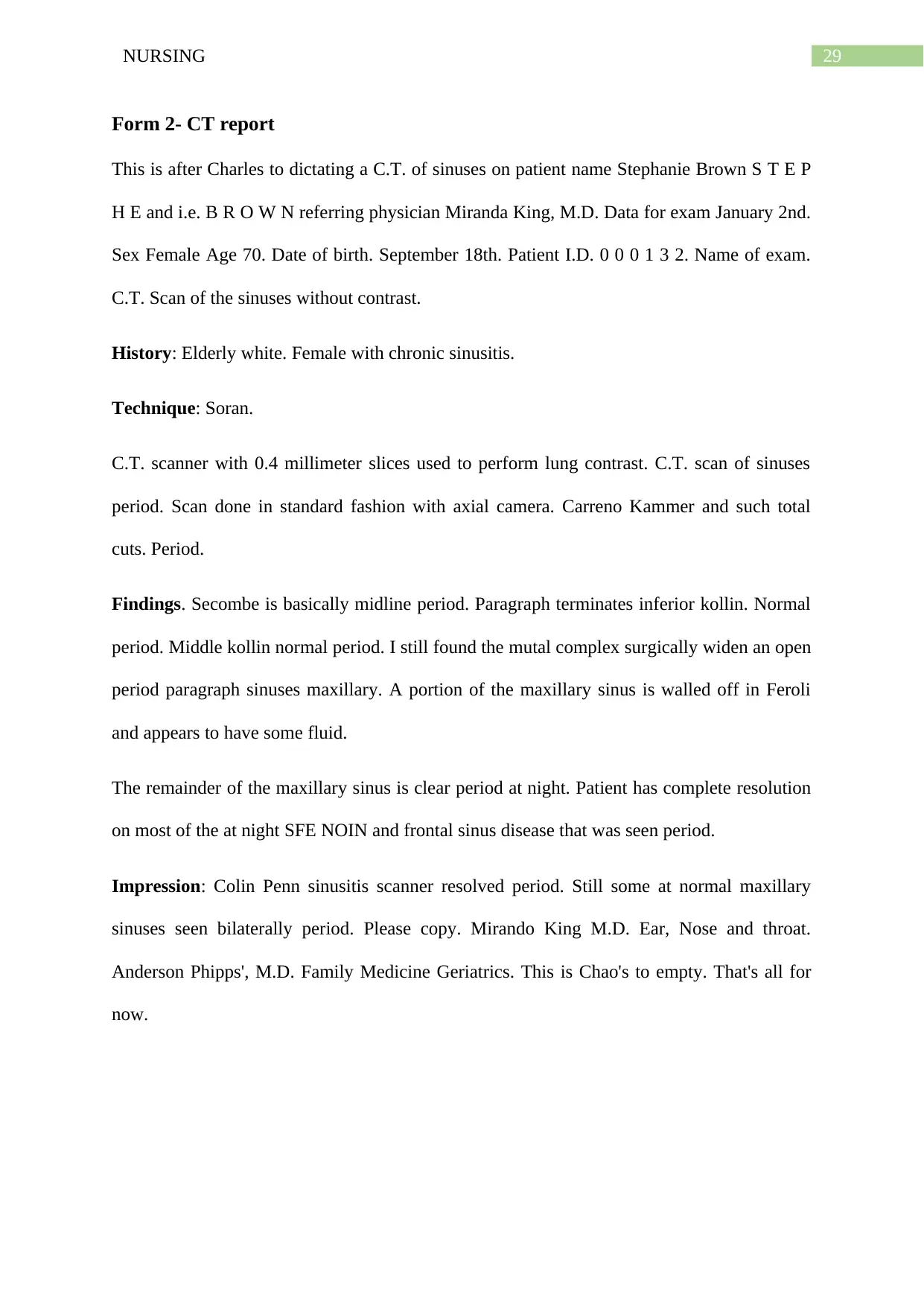
29NURSING
Form 2- CT report
This is after Charles to dictating a C.T. of sinuses on patient name Stephanie Brown S T E P
H E and i.e. B R O W N referring physician Miranda King, M.D. Data for exam January 2nd.
Sex Female Age 70. Date of birth. September 18th. Patient I.D. 0 0 0 1 3 2. Name of exam.
C.T. Scan of the sinuses without contrast.
History: Elderly white. Female with chronic sinusitis.
Technique: Soran.
C.T. scanner with 0.4 millimeter slices used to perform lung contrast. C.T. scan of sinuses
period. Scan done in standard fashion with axial camera. Carreno Kammer and such total
cuts. Period.
Findings. Secombe is basically midline period. Paragraph terminates inferior kollin. Normal
period. Middle kollin normal period. I still found the mutal complex surgically widen an open
period paragraph sinuses maxillary. A portion of the maxillary sinus is walled off in Feroli
and appears to have some fluid.
The remainder of the maxillary sinus is clear period at night. Patient has complete resolution
on most of the at night SFE NOIN and frontal sinus disease that was seen period.
Impression: Colin Penn sinusitis scanner resolved period. Still some at normal maxillary
sinuses seen bilaterally period. Please copy. Mirando King M.D. Ear, Nose and throat.
Anderson Phipps', M.D. Family Medicine Geriatrics. This is Chao's to empty. That's all for
now.
Form 2- CT report
This is after Charles to dictating a C.T. of sinuses on patient name Stephanie Brown S T E P
H E and i.e. B R O W N referring physician Miranda King, M.D. Data for exam January 2nd.
Sex Female Age 70. Date of birth. September 18th. Patient I.D. 0 0 0 1 3 2. Name of exam.
C.T. Scan of the sinuses without contrast.
History: Elderly white. Female with chronic sinusitis.
Technique: Soran.
C.T. scanner with 0.4 millimeter slices used to perform lung contrast. C.T. scan of sinuses
period. Scan done in standard fashion with axial camera. Carreno Kammer and such total
cuts. Period.
Findings. Secombe is basically midline period. Paragraph terminates inferior kollin. Normal
period. Middle kollin normal period. I still found the mutal complex surgically widen an open
period paragraph sinuses maxillary. A portion of the maxillary sinus is walled off in Feroli
and appears to have some fluid.
The remainder of the maxillary sinus is clear period at night. Patient has complete resolution
on most of the at night SFE NOIN and frontal sinus disease that was seen period.
Impression: Colin Penn sinusitis scanner resolved period. Still some at normal maxillary
sinuses seen bilaterally period. Please copy. Mirando King M.D. Ear, Nose and throat.
Anderson Phipps', M.D. Family Medicine Geriatrics. This is Chao's to empty. That's all for
now.
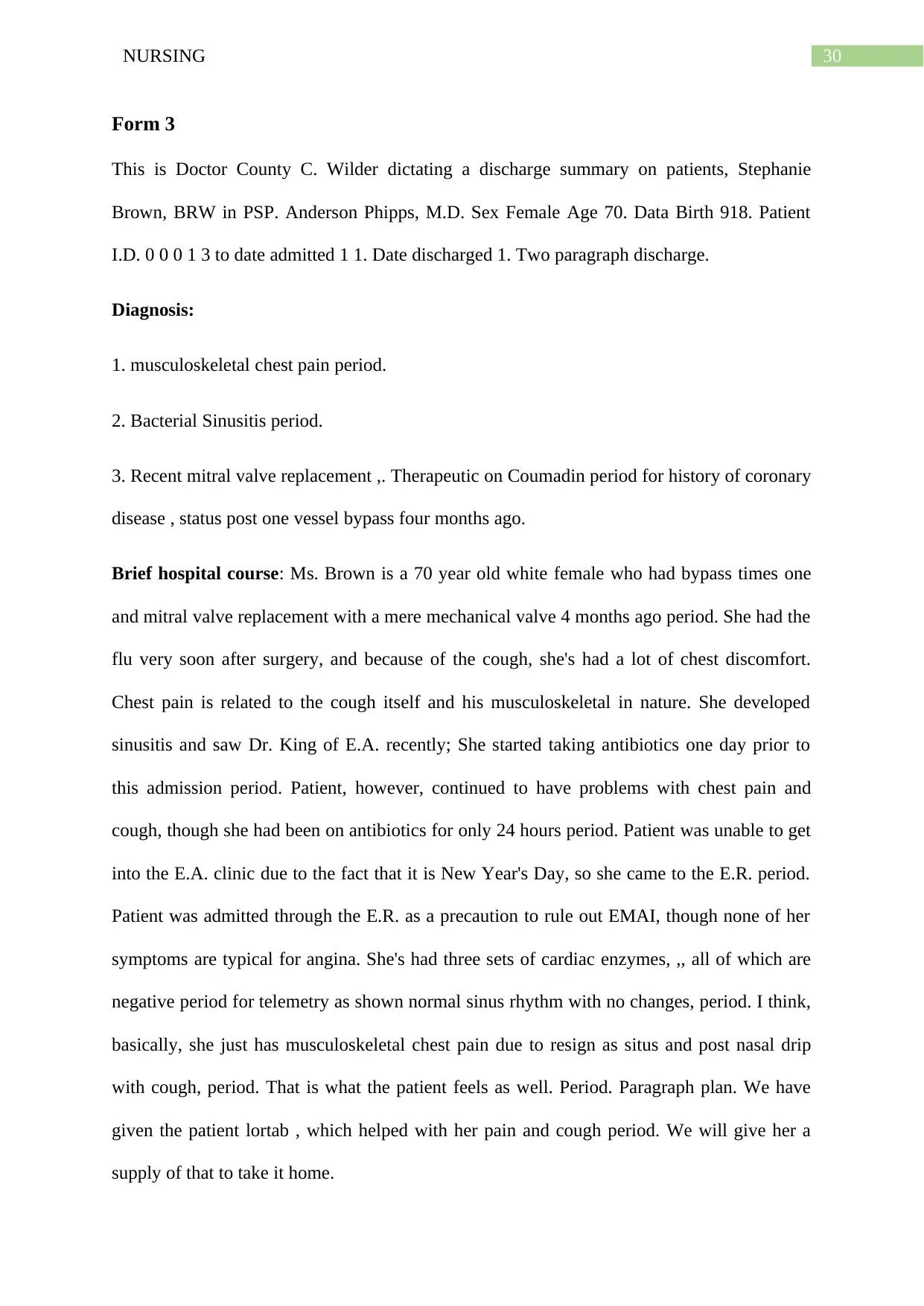
30NURSING
Form 3
This is Doctor County C. Wilder dictating a discharge summary on patients, Stephanie
Brown, BRW in PSP. Anderson Phipps, M.D. Sex Female Age 70. Data Birth 918. Patient
I.D. 0 0 0 1 3 to date admitted 1 1. Date discharged 1. Two paragraph discharge.
Diagnosis:
1. musculoskeletal chest pain period.
2. Bacterial Sinusitis period.
3. Recent mitral valve replacement ,. Therapeutic on Coumadin period for history of coronary
disease , status post one vessel bypass four months ago.
Brief hospital course: Ms. Brown is a 70 year old white female who had bypass times one
and mitral valve replacement with a mere mechanical valve 4 months ago period. She had the
flu very soon after surgery, and because of the cough, she's had a lot of chest discomfort.
Chest pain is related to the cough itself and his musculoskeletal in nature. She developed
sinusitis and saw Dr. King of E.A. recently; She started taking antibiotics one day prior to
this admission period. Patient, however, continued to have problems with chest pain and
cough, though she had been on antibiotics for only 24 hours period. Patient was unable to get
into the E.A. clinic due to the fact that it is New Year's Day, so she came to the E.R. period.
Patient was admitted through the E.R. as a precaution to rule out EMAI, though none of her
symptoms are typical for angina. She's had three sets of cardiac enzymes, ,, all of which are
negative period for telemetry as shown normal sinus rhythm with no changes, period. I think,
basically, she just has musculoskeletal chest pain due to resign as situs and post nasal drip
with cough, period. That is what the patient feels as well. Period. Paragraph plan. We have
given the patient lortab , which helped with her pain and cough period. We will give her a
supply of that to take it home.
Form 3
This is Doctor County C. Wilder dictating a discharge summary on patients, Stephanie
Brown, BRW in PSP. Anderson Phipps, M.D. Sex Female Age 70. Data Birth 918. Patient
I.D. 0 0 0 1 3 to date admitted 1 1. Date discharged 1. Two paragraph discharge.
Diagnosis:
1. musculoskeletal chest pain period.
2. Bacterial Sinusitis period.
3. Recent mitral valve replacement ,. Therapeutic on Coumadin period for history of coronary
disease , status post one vessel bypass four months ago.
Brief hospital course: Ms. Brown is a 70 year old white female who had bypass times one
and mitral valve replacement with a mere mechanical valve 4 months ago period. She had the
flu very soon after surgery, and because of the cough, she's had a lot of chest discomfort.
Chest pain is related to the cough itself and his musculoskeletal in nature. She developed
sinusitis and saw Dr. King of E.A. recently; She started taking antibiotics one day prior to
this admission period. Patient, however, continued to have problems with chest pain and
cough, though she had been on antibiotics for only 24 hours period. Patient was unable to get
into the E.A. clinic due to the fact that it is New Year's Day, so she came to the E.R. period.
Patient was admitted through the E.R. as a precaution to rule out EMAI, though none of her
symptoms are typical for angina. She's had three sets of cardiac enzymes, ,, all of which are
negative period for telemetry as shown normal sinus rhythm with no changes, period. I think,
basically, she just has musculoskeletal chest pain due to resign as situs and post nasal drip
with cough, period. That is what the patient feels as well. Period. Paragraph plan. We have
given the patient lortab , which helped with her pain and cough period. We will give her a
supply of that to take it home.
Paraphrase This Document
Need a fresh take? Get an instant paraphrase of this document with our AI Paraphraser
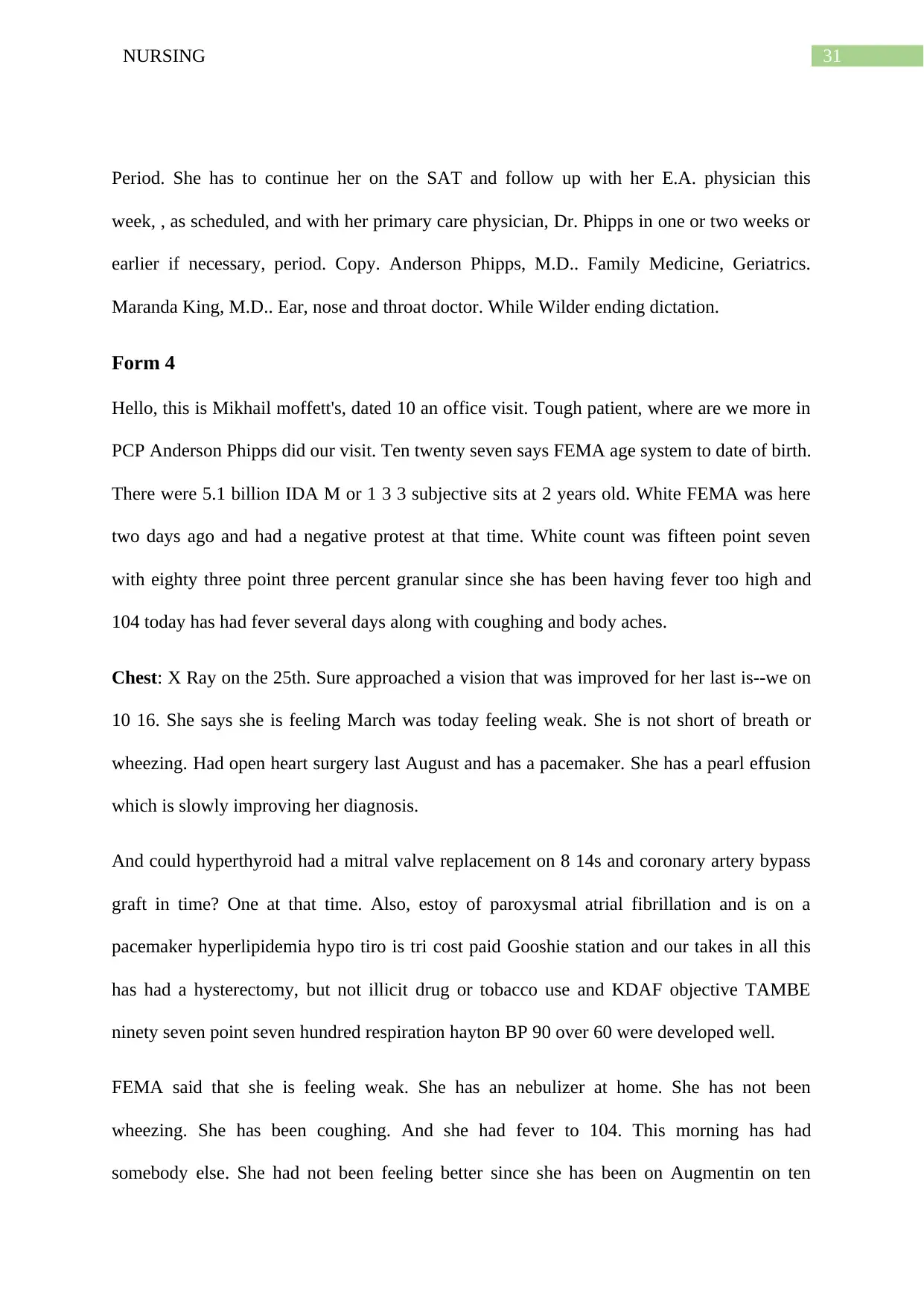
31NURSING
Period. She has to continue her on the SAT and follow up with her E.A. physician this
week, , as scheduled, and with her primary care physician, Dr. Phipps in one or two weeks or
earlier if necessary, period. Copy. Anderson Phipps, M.D.. Family Medicine, Geriatrics.
Maranda King, M.D.. Ear, nose and throat doctor. While Wilder ending dictation.
Form 4
Hello, this is Mikhail moffett's, dated 10 an office visit. Tough patient, where are we more in
PCP Anderson Phipps did our visit. Ten twenty seven says FEMA age system to date of birth.
There were 5.1 billion IDA M or 1 3 3 subjective sits at 2 years old. White FEMA was here
two days ago and had a negative protest at that time. White count was fifteen point seven
with eighty three point three percent granular since she has been having fever too high and
104 today has had fever several days along with coughing and body aches.
Chest: X Ray on the 25th. Sure approached a vision that was improved for her last is--we on
10 16. She says she is feeling March was today feeling weak. She is not short of breath or
wheezing. Had open heart surgery last August and has a pacemaker. She has a pearl effusion
which is slowly improving her diagnosis.
And could hyperthyroid had a mitral valve replacement on 8 14s and coronary artery bypass
graft in time? One at that time. Also, estoy of paroxysmal atrial fibrillation and is on a
pacemaker hyperlipidemia hypo tiro is tri cost paid Gooshie station and our takes in all this
has had a hysterectomy, but not illicit drug or tobacco use and KDAF objective TAMBE
ninety seven point seven hundred respiration hayton BP 90 over 60 were developed well.
FEMA said that she is feeling weak. She has an nebulizer at home. She has not been
wheezing. She has been coughing. And she had fever to 104. This morning has had
somebody else. She had not been feeling better since she has been on Augmentin on ten
Period. She has to continue her on the SAT and follow up with her E.A. physician this
week, , as scheduled, and with her primary care physician, Dr. Phipps in one or two weeks or
earlier if necessary, period. Copy. Anderson Phipps, M.D.. Family Medicine, Geriatrics.
Maranda King, M.D.. Ear, nose and throat doctor. While Wilder ending dictation.
Form 4
Hello, this is Mikhail moffett's, dated 10 an office visit. Tough patient, where are we more in
PCP Anderson Phipps did our visit. Ten twenty seven says FEMA age system to date of birth.
There were 5.1 billion IDA M or 1 3 3 subjective sits at 2 years old. White FEMA was here
two days ago and had a negative protest at that time. White count was fifteen point seven
with eighty three point three percent granular since she has been having fever too high and
104 today has had fever several days along with coughing and body aches.
Chest: X Ray on the 25th. Sure approached a vision that was improved for her last is--we on
10 16. She says she is feeling March was today feeling weak. She is not short of breath or
wheezing. Had open heart surgery last August and has a pacemaker. She has a pearl effusion
which is slowly improving her diagnosis.
And could hyperthyroid had a mitral valve replacement on 8 14s and coronary artery bypass
graft in time? One at that time. Also, estoy of paroxysmal atrial fibrillation and is on a
pacemaker hyperlipidemia hypo tiro is tri cost paid Gooshie station and our takes in all this
has had a hysterectomy, but not illicit drug or tobacco use and KDAF objective TAMBE
ninety seven point seven hundred respiration hayton BP 90 over 60 were developed well.
FEMA said that she is feeling weak. She has an nebulizer at home. She has not been
wheezing. She has been coughing. And she had fever to 104. This morning has had
somebody else. She had not been feeling better since she has been on Augmentin on ten
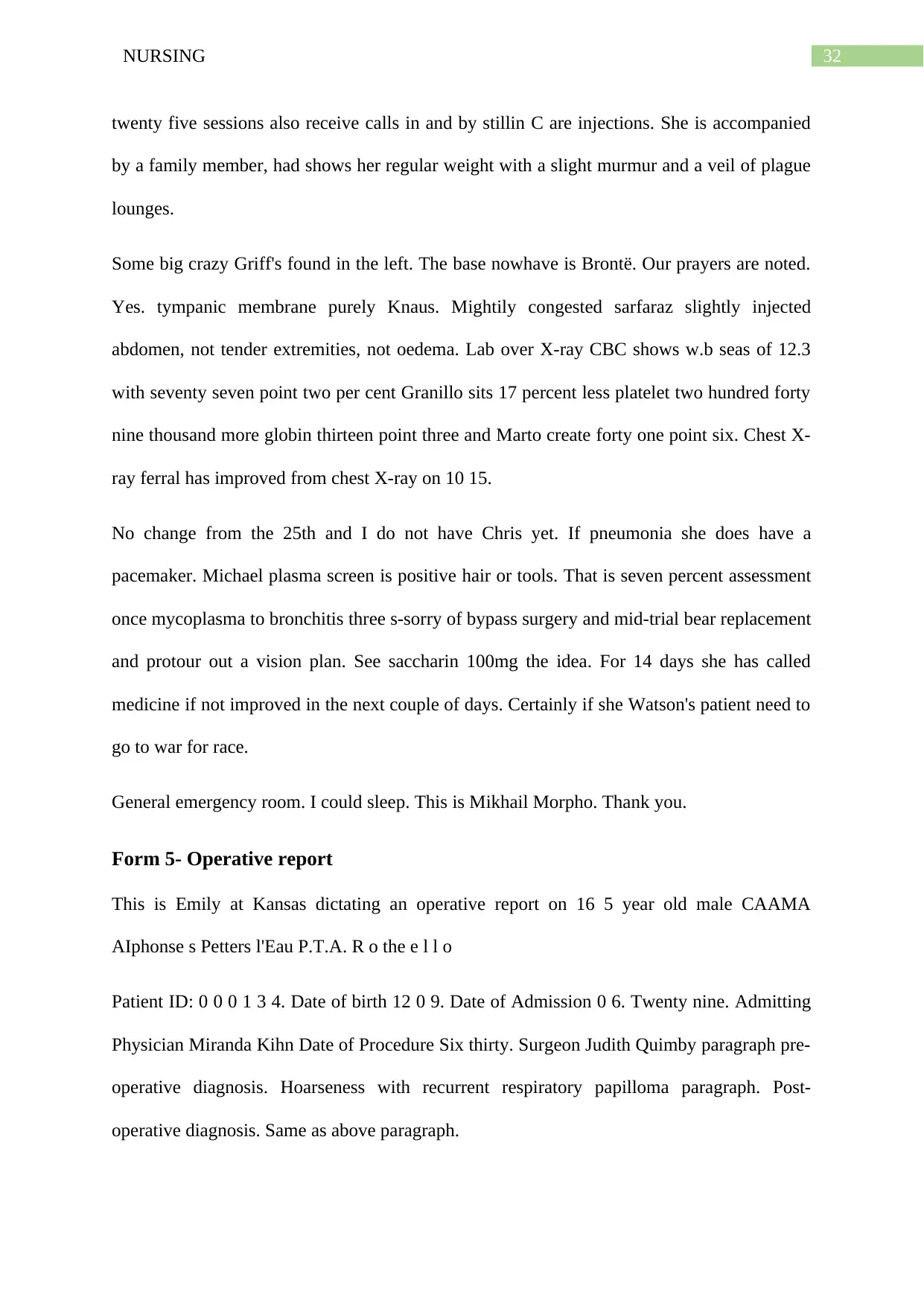
32NURSING
twenty five sessions also receive calls in and by stillin C are injections. She is accompanied
by a family member, had shows her regular weight with a slight murmur and a veil of plague
lounges.
Some big crazy Griff's found in the left. The base nowhave is Brontë. Our prayers are noted.
Yes. tympanic membrane purely Knaus. Mightily congested sarfaraz slightly injected
abdomen, not tender extremities, not oedema. Lab over X-ray CBC shows w.b seas of 12.3
with seventy seven point two per cent Granillo sits 17 percent less platelet two hundred forty
nine thousand more globin thirteen point three and Marto create forty one point six. Chest X-
ray ferral has improved from chest X-ray on 10 15.
No change from the 25th and I do not have Chris yet. If pneumonia she does have a
pacemaker. Michael plasma screen is positive hair or tools. That is seven percent assessment
once mycoplasma to bronchitis three s-sorry of bypass surgery and mid-trial bear replacement
and protour out a vision plan. See saccharin 100mg the idea. For 14 days she has called
medicine if not improved in the next couple of days. Certainly if she Watson's patient need to
go to war for race.
General emergency room. I could sleep. This is Mikhail Morpho. Thank you.
Form 5- Operative report
This is Emily at Kansas dictating an operative report on 16 5 year old male CAAMA
ΑΙphonse s Petters l'Eau P.T.A. R o the e l l o
Patient ID: 0 0 0 1 3 4. Date of birth 12 0 9. Date of Admission 0 6. Twenty nine. Admitting
Physician Miranda Kihn Date of Procedure Six thirty. Surgeon Judith Quimby paragraph pre-
operative diagnosis. Hoarseness with recurrent respiratory papilloma paragraph. Post-
operative diagnosis. Same as above paragraph.
twenty five sessions also receive calls in and by stillin C are injections. She is accompanied
by a family member, had shows her regular weight with a slight murmur and a veil of plague
lounges.
Some big crazy Griff's found in the left. The base nowhave is Brontë. Our prayers are noted.
Yes. tympanic membrane purely Knaus. Mightily congested sarfaraz slightly injected
abdomen, not tender extremities, not oedema. Lab over X-ray CBC shows w.b seas of 12.3
with seventy seven point two per cent Granillo sits 17 percent less platelet two hundred forty
nine thousand more globin thirteen point three and Marto create forty one point six. Chest X-
ray ferral has improved from chest X-ray on 10 15.
No change from the 25th and I do not have Chris yet. If pneumonia she does have a
pacemaker. Michael plasma screen is positive hair or tools. That is seven percent assessment
once mycoplasma to bronchitis three s-sorry of bypass surgery and mid-trial bear replacement
and protour out a vision plan. See saccharin 100mg the idea. For 14 days she has called
medicine if not improved in the next couple of days. Certainly if she Watson's patient need to
go to war for race.
General emergency room. I could sleep. This is Mikhail Morpho. Thank you.
Form 5- Operative report
This is Emily at Kansas dictating an operative report on 16 5 year old male CAAMA
ΑΙphonse s Petters l'Eau P.T.A. R o the e l l o
Patient ID: 0 0 0 1 3 4. Date of birth 12 0 9. Date of Admission 0 6. Twenty nine. Admitting
Physician Miranda Kihn Date of Procedure Six thirty. Surgeon Judith Quimby paragraph pre-
operative diagnosis. Hoarseness with recurrent respiratory papilloma paragraph. Post-
operative diagnosis. Same as above paragraph.
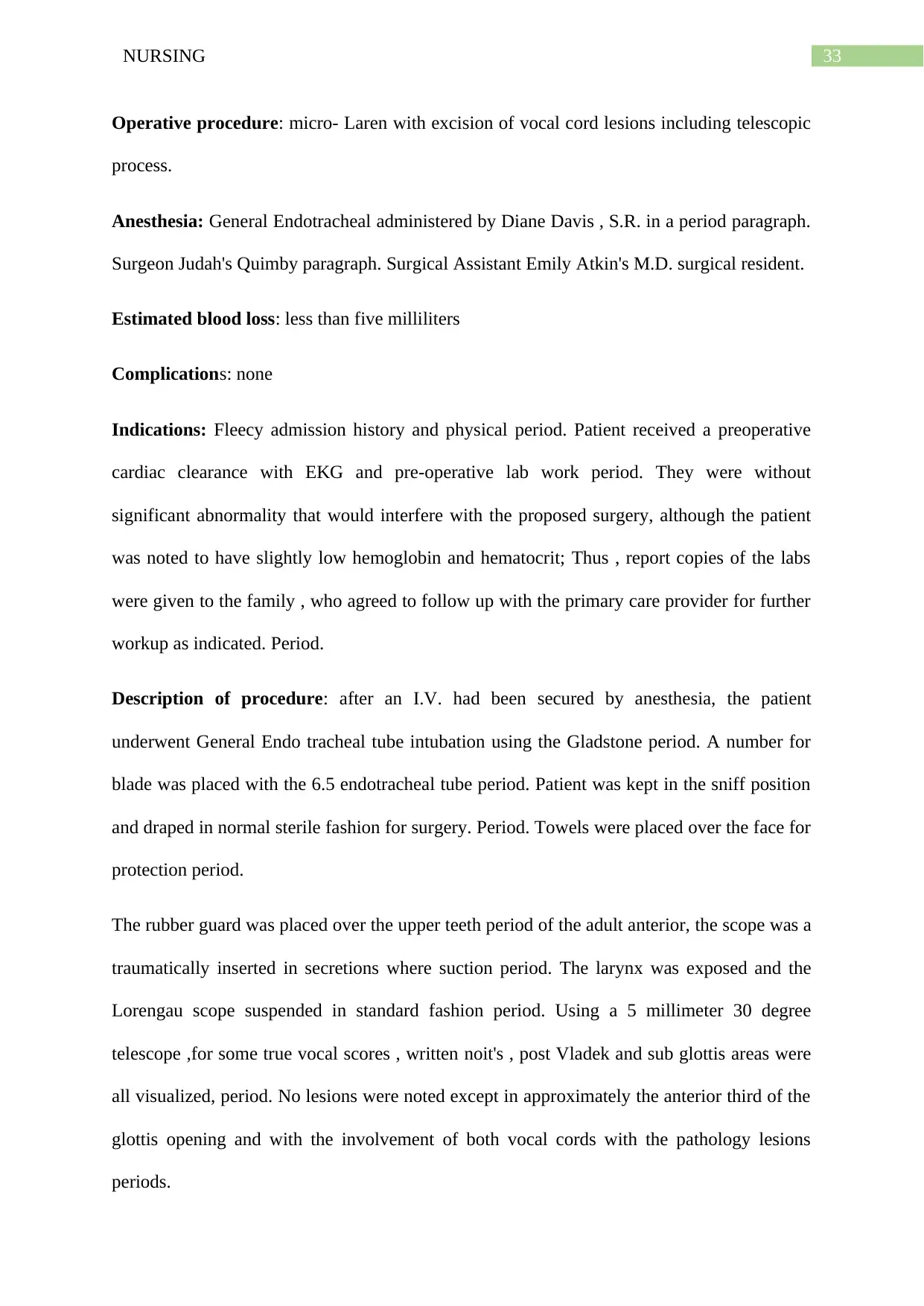
33NURSING
Operative procedure: micro- Laren with excision of vocal cord lesions including telescopic
process.
Anesthesia: General Endotracheal administered by Diane Davis , S.R. in a period paragraph.
Surgeon Judah's Quimby paragraph. Surgical Assistant Emily Atkin's M.D. surgical resident.
Estimated blood loss: less than five milliliters
Complications: none
Indications: Fleecy admission history and physical period. Patient received a preoperative
cardiac clearance with EKG and pre-operative lab work period. They were without
significant abnormality that would interfere with the proposed surgery, although the patient
was noted to have slightly low hemoglobin and hematocrit; Thus , report copies of the labs
were given to the family , who agreed to follow up with the primary care provider for further
workup as indicated. Period.
Description of procedure: after an I.V. had been secured by anesthesia, the patient
underwent General Endo tracheal tube intubation using the Gladstone period. A number for
blade was placed with the 6.5 endotracheal tube period. Patient was kept in the sniff position
and draped in normal sterile fashion for surgery. Period. Towels were placed over the face for
protection period.
The rubber guard was placed over the upper teeth period of the adult anterior, the scope was a
traumatically inserted in secretions where suction period. The larynx was exposed and the
Lorengau scope suspended in standard fashion period. Using a 5 millimeter 30 degree
telescope ,for some true vocal scores , written noit's , post Vladek and sub glottis areas were
all visualized, period. No lesions were noted except in approximately the anterior third of the
glottis opening and with the involvement of both vocal cords with the pathology lesions
periods.
Operative procedure: micro- Laren with excision of vocal cord lesions including telescopic
process.
Anesthesia: General Endotracheal administered by Diane Davis , S.R. in a period paragraph.
Surgeon Judah's Quimby paragraph. Surgical Assistant Emily Atkin's M.D. surgical resident.
Estimated blood loss: less than five milliliters
Complications: none
Indications: Fleecy admission history and physical period. Patient received a preoperative
cardiac clearance with EKG and pre-operative lab work period. They were without
significant abnormality that would interfere with the proposed surgery, although the patient
was noted to have slightly low hemoglobin and hematocrit; Thus , report copies of the labs
were given to the family , who agreed to follow up with the primary care provider for further
workup as indicated. Period.
Description of procedure: after an I.V. had been secured by anesthesia, the patient
underwent General Endo tracheal tube intubation using the Gladstone period. A number for
blade was placed with the 6.5 endotracheal tube period. Patient was kept in the sniff position
and draped in normal sterile fashion for surgery. Period. Towels were placed over the face for
protection period.
The rubber guard was placed over the upper teeth period of the adult anterior, the scope was a
traumatically inserted in secretions where suction period. The larynx was exposed and the
Lorengau scope suspended in standard fashion period. Using a 5 millimeter 30 degree
telescope ,for some true vocal scores , written noit's , post Vladek and sub glottis areas were
all visualized, period. No lesions were noted except in approximately the anterior third of the
glottis opening and with the involvement of both vocal cords with the pathology lesions
periods.
Secure Best Marks with AI Grader
Need help grading? Try our AI Grader for instant feedback on your assignments.
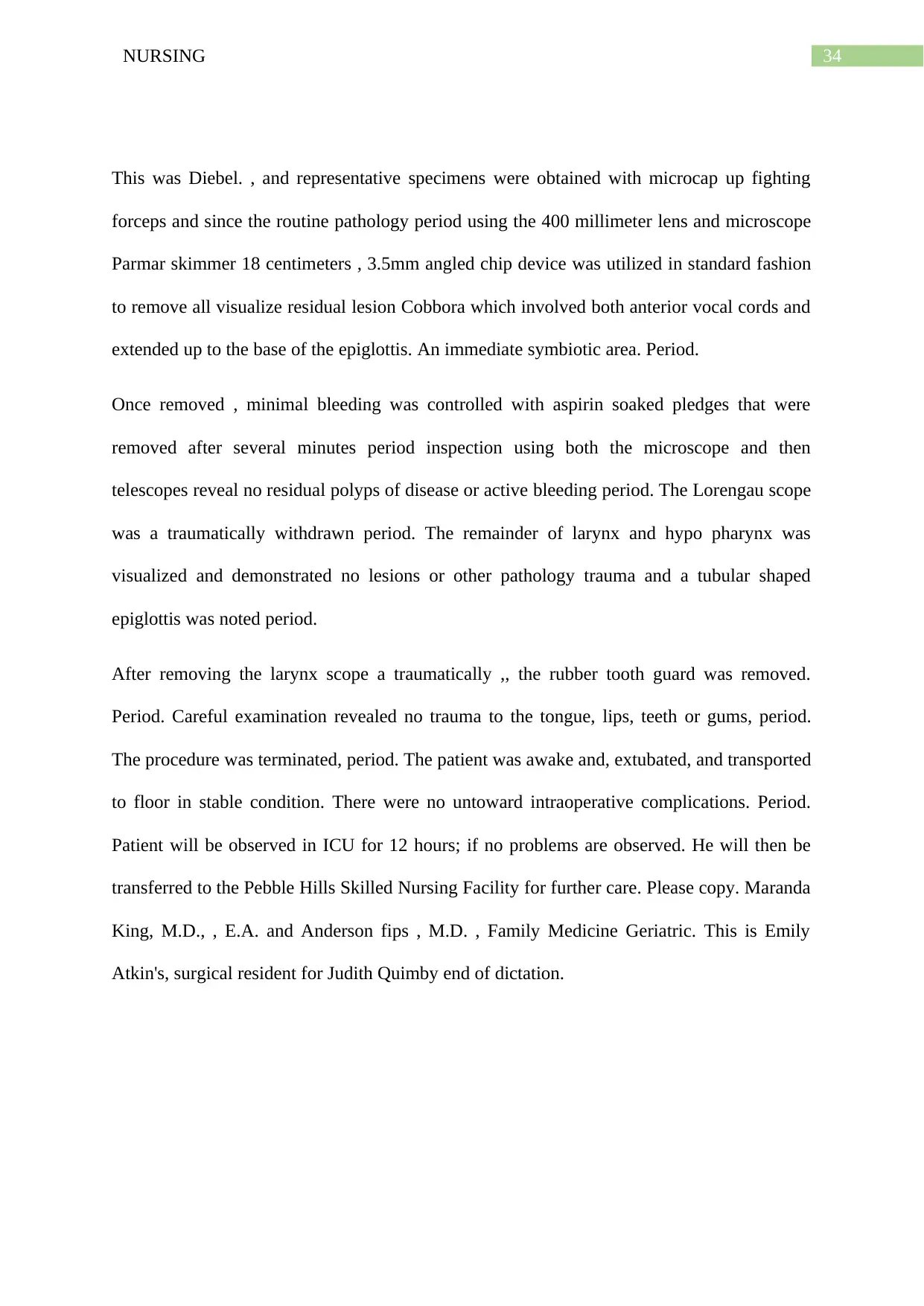
34NURSING
This was Diebel. , and representative specimens were obtained with microcap up fighting
forceps and since the routine pathology period using the 400 millimeter lens and microscope
Parmar skimmer 18 centimeters , 3.5mm angled chip device was utilized in standard fashion
to remove all visualize residual lesion Cobbora which involved both anterior vocal cords and
extended up to the base of the epiglottis. An immediate symbiotic area. Period.
Once removed , minimal bleeding was controlled with aspirin soaked pledges that were
removed after several minutes period inspection using both the microscope and then
telescopes reveal no residual polyps of disease or active bleeding period. The Lorengau scope
was a traumatically withdrawn period. The remainder of larynx and hypo pharynx was
visualized and demonstrated no lesions or other pathology trauma and a tubular shaped
epiglottis was noted period.
After removing the larynx scope a traumatically ,, the rubber tooth guard was removed.
Period. Careful examination revealed no trauma to the tongue, lips, teeth or gums, period.
The procedure was terminated, period. The patient was awake and, extubated, and transported
to floor in stable condition. There were no untoward intraoperative complications. Period.
Patient will be observed in ICU for 12 hours; if no problems are observed. He will then be
transferred to the Pebble Hills Skilled Nursing Facility for further care. Please copy. Maranda
King, M.D., , E.A. and Anderson fips , M.D. , Family Medicine Geriatric. This is Emily
Atkin's, surgical resident for Judith Quimby end of dictation.
This was Diebel. , and representative specimens were obtained with microcap up fighting
forceps and since the routine pathology period using the 400 millimeter lens and microscope
Parmar skimmer 18 centimeters , 3.5mm angled chip device was utilized in standard fashion
to remove all visualize residual lesion Cobbora which involved both anterior vocal cords and
extended up to the base of the epiglottis. An immediate symbiotic area. Period.
Once removed , minimal bleeding was controlled with aspirin soaked pledges that were
removed after several minutes period inspection using both the microscope and then
telescopes reveal no residual polyps of disease or active bleeding period. The Lorengau scope
was a traumatically withdrawn period. The remainder of larynx and hypo pharynx was
visualized and demonstrated no lesions or other pathology trauma and a tubular shaped
epiglottis was noted period.
After removing the larynx scope a traumatically ,, the rubber tooth guard was removed.
Period. Careful examination revealed no trauma to the tongue, lips, teeth or gums, period.
The procedure was terminated, period. The patient was awake and, extubated, and transported
to floor in stable condition. There were no untoward intraoperative complications. Period.
Patient will be observed in ICU for 12 hours; if no problems are observed. He will then be
transferred to the Pebble Hills Skilled Nursing Facility for further care. Please copy. Maranda
King, M.D., , E.A. and Anderson fips , M.D. , Family Medicine Geriatric. This is Emily
Atkin's, surgical resident for Judith Quimby end of dictation.
1 out of 35
Your All-in-One AI-Powered Toolkit for Academic Success.
+13062052269
info@desklib.com
Available 24*7 on WhatsApp / Email
![[object Object]](/_next/static/media/star-bottom.7253800d.svg)
Unlock your academic potential
© 2024 | Zucol Services PVT LTD | All rights reserved.